Does North Korea really pose a military threat to anyone? A comparison of the military assets of the two Koreas.
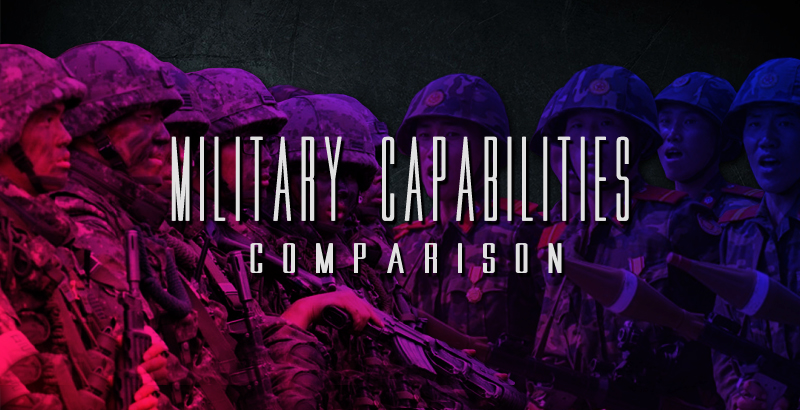
Written by Brian Kalman exclusively for SouthFront; Brian Kalman is a management professional in the marine transportation industry. He was an officer in the US Navy for eleven years. He currently resides and works in the Caribbean.
Introduction
As the very real threat of a military confrontation breaking out on the Korean Peninsula once again becomes probable, it is important to reassess the current military capabilities of both the Republic of Korea (South Korea) and the Democratic Peoples’ Republic of Korea (North Korea). An analysis of the respective militaries will give a clearer picture of the probability of a conflict, and how such a conflict might unfold. A realistic assessment of the balance of power on the peninsula, as well as the forces that can be brought to bear by likely allies, will also provide insight into the motivations of North Korea in developing a viable nuclear deterrent. Is the North Korean leadership as psychologically detached from reality as the western media and governments of the United States, Japan and South Korea would have us believe, or is the possession of nuclear weapons the best way for the DPRK to deter an attack by a much more powerful alliance of adversaries? Also, has the DPRK become a de-facto NBC testing ground for other nations, who use the status of the republic as an international pariah, to advance their own weapons of mass destruction programs clandestinely? Whose vital interests are served by maintaining the communist regime, one based on hereditary succession, in Pyongyang?
While the DPRK possesses the fourth largest army in the world, based on manpower, it is poorly equipped with weapons systems first fielded in the 1950s and 1960s. Furthermore, its conventional forces have not kept pace with the technological innovations that have influenced and shaped the development of weapons systems. South Korea has embraced these technological innovations and has developed a modern, capable military in the time that the forces of the DPRK have stagnated. This is also true for Japan and the United States. In order to compensate for its material inferiority, the DPRK has moved increasingly in the direction of developing asymmetrical assets and capabilities, as well as increasing its investment in nuclear weapons procurement and the development of a reliable delivery system for these weapons.
Defense Strategy
The DPRK has largely maintained the same military strategy on the peninsula since the end of the Korean War; however, this strategy has been modified numerous times to take into account the changing military balance of power which has increasingly turned to the advantage of the ROK. A majority of the ground forces of the DPRK are forward deployed, close to the demilitarized zone (DMZ). This minimizes logistics costs, in that units will not have to be repositioned in case the decision is made to invade or to conduct limited offensive operations over the border. The forward deployment also forces the ROK to always maintain a sizeable blocking force in a high state of readiness along the southern periphery of the DMZ. The constant threat of invasion from the north also magnifies the effect of any political saber rattling coming out of Pyongyang.
The viability of the DPRKs forward deployment of large numbers of ground forces, including a high concentration of high caliber artillery units, the majority of which are towed and not self-propelled, has come into question in recent years. Deploying a large portion of the DPRKs ground forces, many of them with limited mobility, as well as the heavy investment over the decades in a vast network of static defensive fortifications, opens up these forces to be rapidly flanked via amphibious and air assault operations. It might be assumed that the leadership of the DPRK would have learned this lesson in the Korean War, when they were outflanked by an amphibious operation at Inchon. This operation was pivotal in the North’s complete defeat, and they were only saved from complete annihilation by China’s entry into the war.
Although quite reliant on U.S. military power after the cessation of the Korean War and through most of the Cold War, South Korea has invested a great deal of its economic wealth into modernizing the ROK military and becoming increasingly less dependent on the armed forces of the United States. While the ROK wisely maintains close military ties with the United States, and increasingly with Japan since Shinzo Abe’s time as Prime Minister, it also utilizes many weapons systems that provide interoperability with both Allies’ radars, communications, and battle management systems. The ROK Navy uses the Aegis system and can work with both U.S. Navy and JMSDF guided missile destroyers in targeting and defeating cruise missiles and aircraft or other surface combatants. Although there are still almost 30,000 U.S. troops still stationed in South Korea, the ROK military has become increasingly self-reliant in providing for the defense of the nation. The indigenous arms industry has produced a number of modern and capable armored vehicles, weapons systems, and even aircraft. The shipbuilding industry in the south is a world leader in producing maritime tonnage, and has also produced a number of modern warships of various classes. While the north operates a stagnant communist economy, the south is an economic powerhouse, ranking as the 11th largest economy in the world per GDP.
The ROK Air Force maintains a significant qualitative edge over its northern counterpart. Most importantly, South Korean pilots log far more flight hours than their adversaries, and receive realistic combat flight training. It is estimated that North Korean pilots receive 20-25 hours of flight time a year, while South Korean pilots receive at least 130-150 flight hours annually. While Seoul has equipped its fighter and tactical air wings with modern, third and fourth generation aircraft, Pyongyang relies on fighters and attack planes largely developed in the 1960s. Although robust and reliable, a Mig-21 cannot compare to an F-15K or F-16C in aerial combat.
One area where the ROK has lagged behind in providing for its own defense is in the realm of Ballistic Missile Defense (BMD). The resent deployment of a THAAD battery from the United States is a clear sign that although the DPRK has been making progress in its quest to develop a smaller nuclear weapon, deliverable on a reliable ballistic missile, the ROK has done little to counter this growing threat. South Korea has done little to develop capable medium to long range surface-to-air missiles (SAM), as the DPRK Air Force presents less of a threat today than at any other time in the conflict. The ROK does operate eight batteries of MIM-104 Patriot of the PAC-II variation. It is planned to upgrade these systems to the PAC-III standard while hosting a larger number of THAAD batteries in the near future.
Ground Forces
When comparing the strength of the ground forces of each nation, over-emphasis on total men and women in uniform does not allow for an accurate assessment of strength, quality or mobility. It is one thing to have 1 million troops, but how well are they trained, how rapidly can they move on the modern battlefield, what force multipliers are available to them, how effective is the command and control system that leads them, and how able and adaptive is the all-important logistics echelon that supports them? While the DPRK can field greater numbers of troops, how do they compare to their southern counterparts?
DPRK Korean Peoples’ Army
Total active personnel in the KPA is approximately 1.2 million, with a further 600,000 personnel in reserve status. In addition, including the Worker-Peasant Red Guards, there are approximately 6 million additional personnel organized in some type of quasi-military establishment. This means that roughly one quarter of the total population of the country has some form of military training and familiarization and can be mobilized for national defense emergencies. These units are most likely provisioned with older small arms, little in the way of ammunition and equipment, and there combat value is minimal. Without the direction of the regime leadership and the vertically-oriented military hierarchy, command and control of a large mass of “worker-peasant” troops would prove impossible for the Regime, and may actually lead to some percentage of such forces rebelling against the state in a time of war or national emergency, especially if the regime was targeted with a successful decapitating strike that eliminated the upper echelon of leadership in Pyongyang.
Infantry and Mechanized Infantry
The overwhelming majority of KPA units are classified as infantry or light infantry. The first echelon of defense is comprised of four infantry corps; I Army Corps, II Army Corps, IV Army Corps, and V Army Corps. Each Army Corps is comprised of four infantry divisions with the exception of the II Army Corps which consists of three infantry divisions only. These infantry formations occupy a number of extensively fortified system of tunnels and bunkers along the DMZ, and extended to a significant depth. The four corps are supported by an independent artillery corps, the 620th Artillery Corps.
Positioned behind the infantry corps are two mechanized infantry corps and one armored corps, the 806th Mechanized Corps, 815th Mechanized Corps, and the 820th Armored Corps, which comprise the second echelon of defense. Each mechanized infantry corps consists of 5 mechanized infantry brigades. These mobile units can respond quickly to reinforce vulnerable areas of the front line, rapidly exploit offensive opportunities that present themselves, and to counterattack as needed. They are a strong second echelon of defense and form a powerful mobile reserve that can bolster defense or spearhead a counterattack.
The third echelon of defense is comprised of three infantry corps, the III Army Corps, VII Army Corps, and XII Army Corps each comprising of two to three infantry divisions. An additional 8 Reserve Infantry Divisions are incorporated in the table of organization and equipment (TO&E) of the three corps. These infantry corps are supported by an independent artillery corps, the Kangdong Artillery Corps. In addition, Pyongyang has at least four infantry brigades tasked with the defense of the capital, which are directed by the Pyongyang Defense Command.
The fourth echelon of defense is comprised of four infantry corps, the VIII Army Corps, IX Army Corps, X Army Corps and XI Army Corps, and two mechanized infantry corps, the 108th Mechanized Corps and the 425th Mechanized Corps. Each Army Corps consists of at least two infantry divisions, and each Mechanized Corps is comprised of five mechanized infantry brigades and possibly a number of light infantry brigades. These units are positioned furthest away from the DMZ; however, they are tasked with securing the border with China and most of the long eastern coastline adjacent to the Sea of Japan.
The infantry are equipped with Soviet era weapons or licensed and unlicensed clones of them. Most of these small arms were designed and supplied to North Kore in the 1950s and 1960s, when relations with the Soviet Union were quite good, and the Cold War was in full swing. The Russian Federation has not been as willing to supply North Korea with more modern infantry weapons, such as modern versions of the AK-74 assault rifles (although the KPA uses local copies) and current generation Anti-Tank Guided Missiles (ATGMs). This is for a combination of reasons, mostly political (adhering to the stipulations of the UN) and also to minimize the unlicensed manufacture and sale of reverse engineered clones of Russian weapons. North Korean clones of Russian small arms are noted for their inferiority to the originals, yet they are good enough copies to provide reliable and effective weapons to the frontline and reserve forces of the KPA.
The mechanized infantry units are divided into 4 mechanized infantry corps, with half of these positioned within 100 kilometers of the DMZ. The armored vehicles utilized by the mechanized formations are all either vehicles originally imported from China and the Soviet Union, or indigenously manufactured analogs of the same. The majority of the vehicles used by the mechanized corps are either Soviet BTR-60 and BTR-80 or their indigenous clone variant the M-2010 (which is produced in both a 6×6 and 8×8 version), or the Chinese Type-63. The Type-63 was also cloned and manufactured indigenously as the VTT-323. The DPRK has also developed the Type-63 into an amphibious light tank, the BT-85, and have also married components of both the M-2010 and BT-85 into an APC known as the Chunma-D (Model-2009). The only Infantry Fighting Vehicle (IFV) in the DPRK inventory is the BMP-1, which is known locally as the Korshun. The KPA does not possess a modern IFV on par with those fielded by Russia, China, ROK, Japan or the United States.
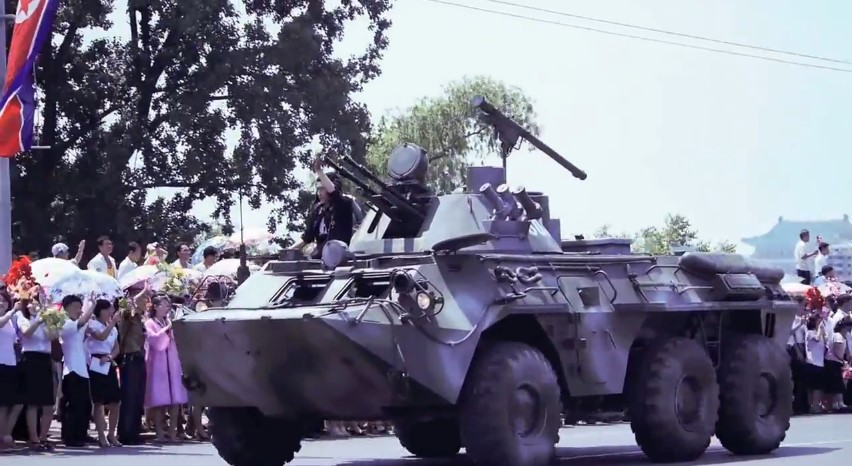
DPRK M-2010 6×6 version of the Soviet BTR-80 wheeled APC. The M-2010 is more widely produced in the 8×8 version, a reverse-engineered BTR-80.
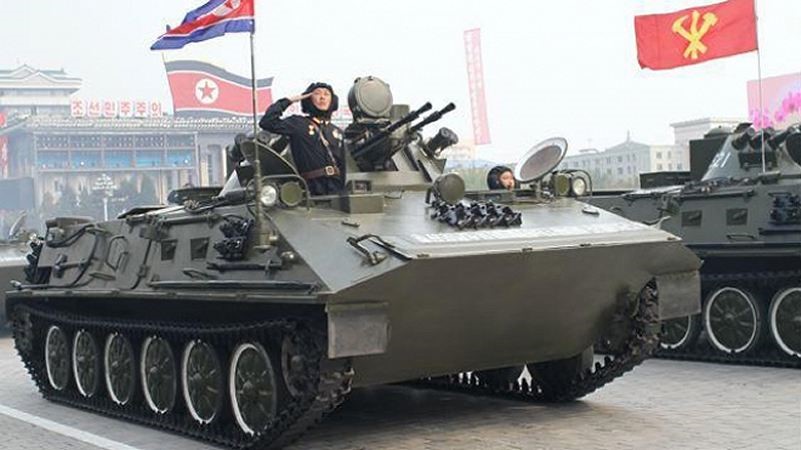
North Korean Chunma-D APC. This is an indigenous design based on both the Russian BTR (turret) and the Chinese Type-63.
Armor
Perhaps the most glaringly obvious example of just how far behind the DPRK has lagged technologically concerning armored weapon systems is in the realm of main battle tank (MBT) design. The KPA has thousands of tanks in active armored formations, as well as thousands in reserve. The frontline MBTs are all based on the Soviet T-55 and T-62 designs. As their designation denotes, these armored vehicles were designed and fielded during the 1950s and 1960s. The most modern MBT in the DPRK inventory is the Pokpung-ho. The Pokpung-ho is apparently based on both the T-62 and the T-72, yet heavily modified and with a number of key upgrades. The Pokpung-ho has a lengthened T-62 chassis, some resemblance to the T-72 hull, the addition of explosive reactive armor panels (Pokpung-ho III upgrade) and the addition of composite armor panels to the forward facing aspect of the turret. The Pokpung-ho II and III appear to be armed with a 125mm smooth bore cannon, with all earlier versions armed with a 115mm main gun. There are between 500 and 1000 units of the Pokpung-ho of all variants in service with the KPA, and 1000 units of the Chonma-ho (based on the T-62M). A further 2,500 MBTs are in service, including those held in reserve armor pools. These numbers consist mainly of T-62M, T-55 and Type-59 models. In addition, the KPA has maintained hundreds of amphibious light tanks both of Soviet and indigenous design, most likely to complement the fleet of aging amphibious assault ships in the Korean Peoples’ Navy. It is also quite probable that a considerable number of T-34(85) tanks are also still present in reserve armor depots in the country.
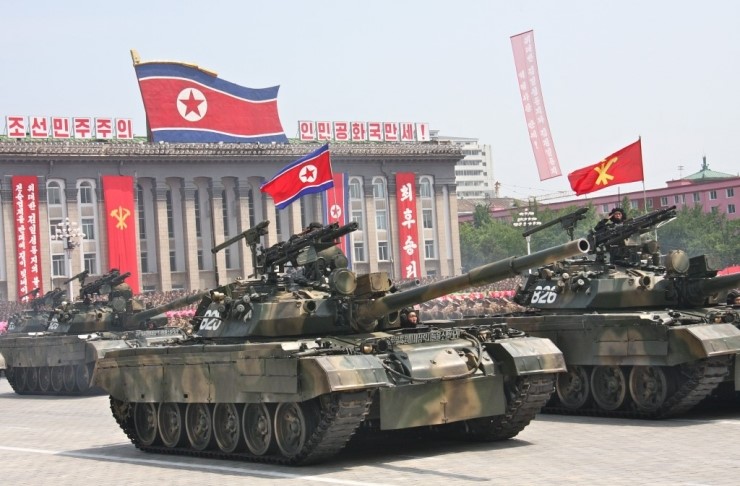
Pokpung-ho III MBTs on parade in Pyongyang. Note the provision of a MANPAD and two ATGMs on the top of the turret. The addition of armor to the T-62 hull and turret front are clearly visible.
Artillery
Perhaps the only clear advantage that the DPRK has over the ROK in military terms is their overwhelming advantage in both conventional and rocket artillery. There are approximately 8,600 artillery pieces, both self-propelled and towed, and roughly 5,500 multiple rocket launch systems (MLRS) deployed in the artillery corps of North Korea. At least half of this artillery is positioned forward, along the DMZ and the larger MLRS systems are within range of striking the southern capitol of Seoul.
The KPA has two independent artillery corps. These corps utilize both self-propelled (SP) artillery systems and towed systems. The conventional artillery guns range in caliber, from 100mm up to 170mm. The largest self-propelled gun system is the Koksan M-1989, which marries what is believed to be an early Soviet designed naval or coastal defense gun to a vehicle that is based on an elongated T-55 chassis. The Koksan can fire rocket assisted projectiles to a range of approximately 60 km. (37 miles). This range was proven during the first Gulf War, when Iraqi artillery batteries equipped with the Koksan harassed Kuwait during the initial invasion.
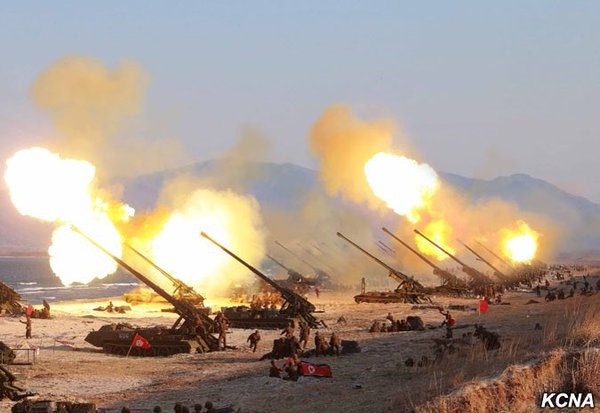
Koksan M-1989 heavy artillery batteries conducting live fire exercises on the western coast of North Korea.
In addition to the thousands of conventional artillery guns, the KPA has many MLRS systems of large caliber, including 200mm., 240mm., and 300mm. The test firing of a new, indigenously designed and produced, self-propelled MLRS based on a heavy truck chassis was made public on March 3, 2016 for propaganda effect, complete with Kim Jung-Un in attendance. Although it was first witnessed during a military parade on October 10, 2015, the video footage taken on March of last year was the first time its actual use was demonstrated publicly. Some analysts believe that the rocket utilized by the system is based on the Chinese SY300. The SY300 can be equipped with a guidance system, utilizing a combination of satellite and inertial navigation. It is unknown whether or not the rocket used in this new system has such capability, but it most likely has the maximum range of 100km to 130km. (62-80miles).
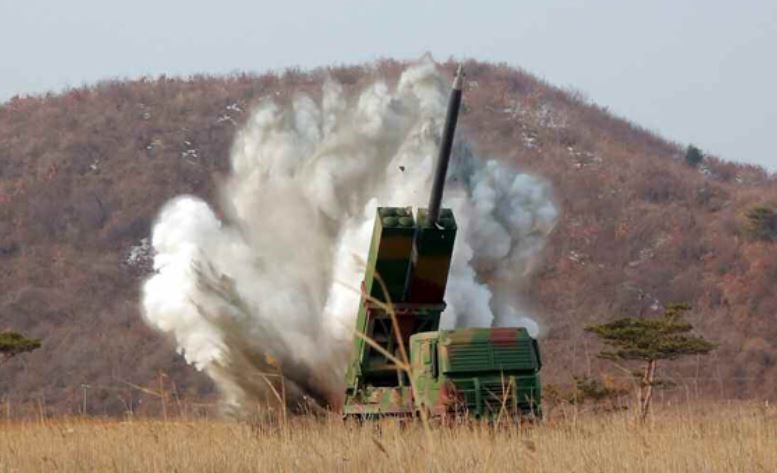
March 3rd, 2016 test firing of indigenously manufactured 300mm MLRS system based on a Chinese heavy truck chassis, and possibly the Chinese SY-300 guided rocket.

The map shows the estimated range and theoretical concentration of explosives from a massive DPRK bombardment of the ROK.
Although previous statements made by the regime leadership in Pyongyang have touted that in case of war, the long range artillery at their disposal would be unleashed to turn Seoul into a “sea of fire”, the probability that this would happen is rather low. A massive barrage with the southern capitol as its target, and not military installations and troop concentrations would reap little rewards for the KPA in real terms, and would expose them to counterbattery fire, and air attack. Limited battery fire on the capitol would most likely occur, for the purposes of propaganda, but would not be the concentrated barrage of thousands of rockets as feared. Military installations and troop concentrations would bear the brunt of any massed barrages.
Republic of Korea Army
The ROK Army has a total active personnel of 490, 000, yet military reforms aim to reduce this total down to 400,000. There are an additional 4.5 million men and women in reserve status, split between the Mobilization Reserve Force (first 4 years of reserve duty) and the Homeland Reserve Force (last 4 years of reserve duty). The ROK has a system of compulsory military service for all males between the ages of 18 and 35. Two years are spent on active duty, and an additional 8 years in reserve status. While the active ground forces suffer an obvious numerical disadvantage compared to their northern adversary, they enjoy the advantages of far better equipment, technologically superior weapon systems, better training, and the support of a modern and capable air force. These factors go a long way in leveling the playing field, and considering the defensive treaty shared with the United States, the ROK can count on the added resources of the U.S. forces based on the peninsula, as well as those in Japan, Guam, and Saipan. The United States has a 28,000 strong contingent of troops based in South Korea, and an additional 50,000 troops permanently based in Japan.
Infantry and Mechanized Infantry
The ground forces of the ROKA have undergone a significant restructuring to reduce command and control, and logistics redundancies to streamline the Army. At the same time, the service is gradually being reduced in size from 47 divisions (22 active) down to 38, with an accompanying reduction in manpower of approximately 18%. The consolidation of army sized units has led to the First Operations Command and Second Operations Command, both in control of what amounts to two armies each. Each army consists of four army corps, with the addition of artillery, engineer and support elements attached. The military branches of South Korea are structured to largely mirror their U.S. counterparts, and they utilize a mixture of both U.S. and locally designed and manufactured equipment and weapons systems. The small arms and personal equipment are all of U.S. origin. This fact aids the U.S. and ROK ground forces’ ability to work together and simplifies logistics considerably. Even weapons systems and armored vehicles manufactured in South Korea share many components with their closest U.S. analogs.
The ROK Army has three mechanized infantry divisions, each consisting of three brigades. The 8th Infantry Division comprised of the 10th, 16th and 21st Infantry Brigades, the 26th Infantry Division comprised of the 73rd, 75th and 76th Infantry Brigades, and the 30th Infantry Division comprised of the 90th, 91st and 92nd Infantry Divisions are all under the command of Second Operations Command. The majority of the armored vehicles in these divisions are the older K-200 armored personnel carrier (APC), based on the venerable M113/AIFV vehicle, and the new, indigenously produced K-21 infantry fighting vehicle (IFV). The K-200 shares many of the design features of the U.S. produced AIFV and is produced locally by Daewoo (now part of Doosan). It is very similar in appearance to the Turkish Army’s ACV family of armored vehicles, because both are based on the AIFV.
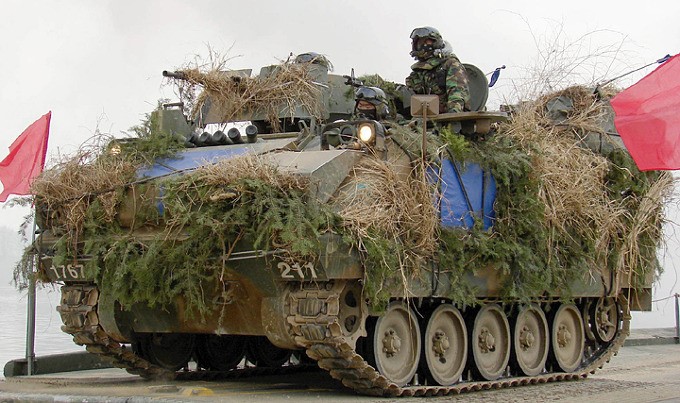
Heavily camouflaged K-200 APC during a winter military exercise.
A vast improvement over the K-200, the K21 IFV is produced by Doosan Infracore, a subsidiary of Doosan Corporation, and is a next generation IFV. The K21 provides greater mobility, armor protection, and firepower than the K-200. It is superior to the U.S. M3A2 Bradley in most respects, providing greater base armor protection, greater internal space for infantry (9 men), and the added firepower of a 40mm autocannon. The locally produced Bofors 40mm autocannon has a rate of fire of 300 rounds/minute and can defeat light tanks and other armored combat vehicles at a considerable range. The K21 also carries two ATGMs and a coaxially mounted 7.62mm machine gun. The first examples of the K21 were fielded beginning in 2011, and deliveries have continued through 2017.
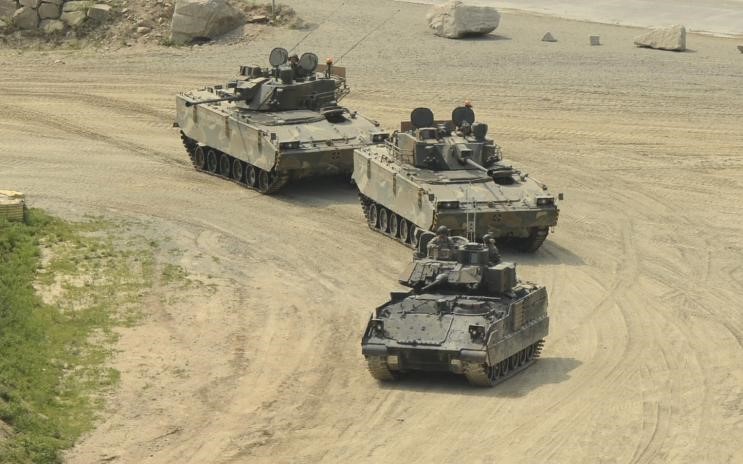
Two K21 IFVs follow an M3A2 Bradley at a military base in South Korea. Note the size comparison of the different vehicles.
The K21 chassis has been utilized in a number of different new generation armored vehicles, including a number of self-propelled anti-aircraft systems. One drawback that comes with the heavy weight of the vehicle is its low inherent buoyancy when swimming. Large side floats carried on each side of the IFV must be deployed and inflated to enable it to ford deep water. The ROK Army requires that all of its frontline armored vehicles be fully amphibious, due to the multitude of rivers that cross the Korean peninsula from east to west. There are 16 main rivers, with many tributaries flowing into these large bodies of water. Amphibious vehicles are required to maintain the needed tempo of the spearhead of operations, dispensing with the need to wait for heavy bridging apparatus to be moved up to the front and constructed.
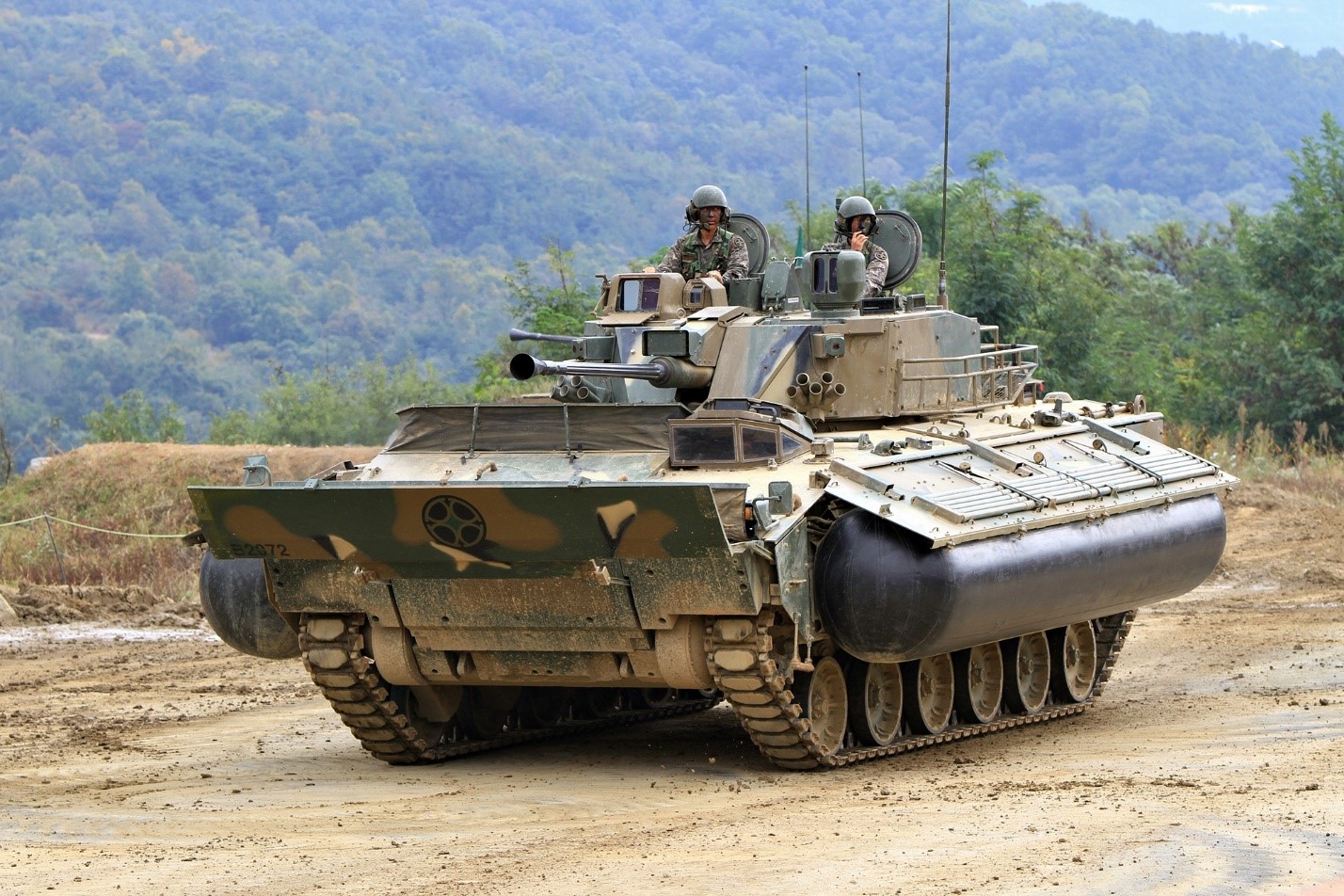
K-21 with waterproof screens and swim floats deployed. The need for this added equipment is a weakness in the vehicle design that Doosan Infracore is still working to correct.
Armor
The ROK Army has four armored brigades in active service, one with the First Operations Command and three with the Second Operations Command. There are approximately 1,500 K1 and K1A1 tanks currently in service, as well as approximately 300 K2 Black Panther next-generation MBTs. The K1A1 is most comparable to the M1A1 Abrams, while many analysts consider the K2 to be the most advanced MBT in the world, in close competition with the T-14 Armata and the M1A2SEPv.3. While its armor protection is at least as good as the latest M1 Abrams, the K2 is equipped with an Active Protection System and other countermeasures (which the M1A2SEPv3. lacks) and yet weighs 7 tons less than the American tank. The K2 is the most expensive MBT in production anywhere in the world, at $7.5 million USD per unit. The K2 utilizes only indigenous technology and manufacturing methodology, and shows just how far the South Korean defense industry has advanced since the 1980s. The Black Panther is a largely overlooked and unknown MBT, yet in many ways it is at the pinnacle of armored vehicle development. It is definitely a significant force multiplier for the ROK in meeting and defeating any military incursion from the north.

A heavily camouflaged K1A1/A2/E2 MBT during maneuvers close to the DMZ.
The remainder of South Korea’s armored strength is comprised of the M48A5K1/K2, which are a greatly updated version of the M48 Patton, first fielded by the United States in 1952. The M48A5Ks are up-gunned with a KM68A1 105mm cannon, and equipped with modern laser range finder, ballistic computer and fire control system. There are approximately 800 M48s of both the A3K and A5K variants in service with the ROK Army.
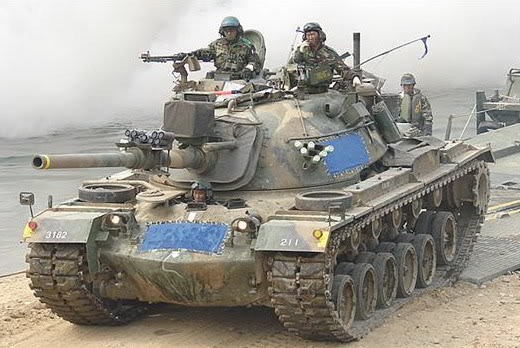
M48A5K2 (the K1 is fitted with side skirts) during a river crossing training operation. Although an older tank design, the updated M48A5K tanks are very well suited to the mountainous terrain that makes up 70% of the Korean peninsula, and they afford a good balance of mobility, firepower and armor protection when considering the majority of tanks that they are likely to face in combat.
Artillery
Although the DPRK is well known for its love of the “King of Battle”, the ROK also fields a large number of both conventional and rocket artillery, although the majority is smaller in caliber. What the ROK artillery lacks in caliber it makes up in accuracy and mobility. The majority of the ROK’s artillery, in both conventional and rocket form, is self-propelled and has higher mobility, and as a result, both tactical and strategic benefits.
While the ROK Army has approximately 4,000 to 5,000 towed artillery pieces both in active and reserve status, mostly 105mm. and 155mm. howitzers, it has approximately 2,000 self-propelled howitzers of the K55A1 and K9 Thunder type. The K55A1 is the equivalent of the U.S. M109 Paladin, while the K9 is a next generation self-propelled gun that is a marked improvement over the Paladin system. The K9, produced by Samsung Techwin, has much improved off-road mobility, increased survivability, greater operational range, and a better ballistics computer and fire control system than its predecessor. It has the ability to operate with less crew, and can even increase its rate of fire through the use of an automated Multi-Round Simultaneous Impact (MRSI) function. When in MRSI mode, the K9 can fire a round every 5 seconds for 15 seconds. The rounds are fired at different times, but also at different trajectories, so that they arrive on the same target area at the same time.
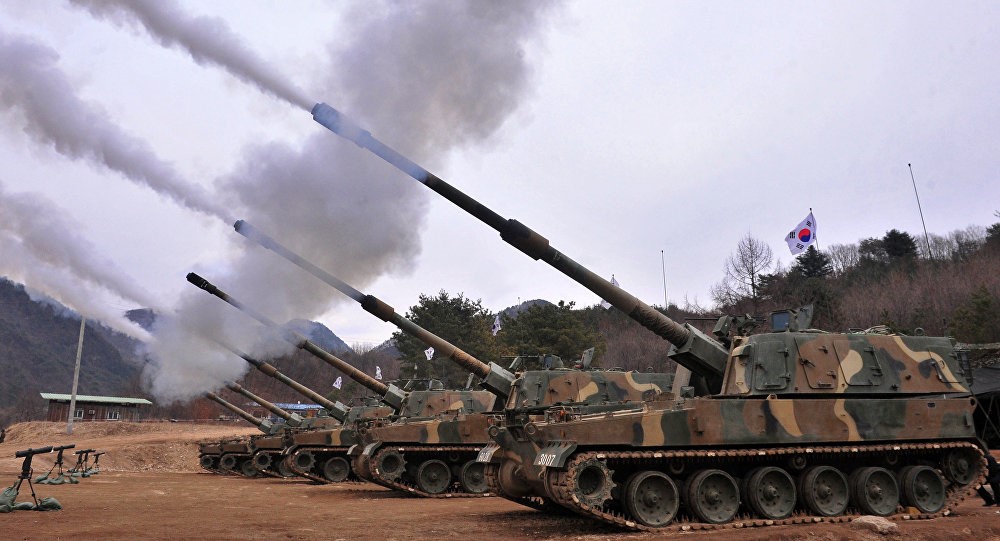
A battery of K9 Thunder SP-ARTY fires during training exercises. Although the ROK lacks the numbers achieved by the DPRK in units of artillery, greater accuracy and rate of fire greatly reduce any advantage in numbers. Greater mobility also renders the ROK less vulnerable to counter-battery fire.
There are two main MLRS systems in use by the ROK Army, the U.S. manufactured M270 and the South Korean manufactured Chunmoo. The M270 is a tracked vehicle based on an elongated M3 Bradley chassis. The M270 has undergone significant upgrades since it was first introduced in the U.S. Army in 1983. The M270 can launch the entire family of Army Tactical Missile System (ATACMS) missiles, some out to a range of 165km. Lockheed Martin developed the GMLRS (Guided MLRS) in 2002 and it is now a standard armament for the system. The GLMRS utilizes a GPS and inertial guidance system fitted in the nose of the XM30 rocket, which turns the rocket into a guided projectile. The XM30 also has an increased range of 70km.
While the M270 gains the added cross country mobility inherent in a tracked vehicle, which is a key benefit in South Korea’s mountainous terrain, the ROK Army requested that a locally produced replacement MLRS must be mounted on a wheeled chassis. The requirement of a wheeled vehicle is based on the desire to gain speed in moving the MLRS rapidly along established roads and even moderately rough terrain, in an attempt to quickly adapt to the tactical and strategic realities of a fluid modern battlefield, to reduce the probability of losses due to counter-battery fire, and to quickly be able to deploy and relocate powerful rocket artillery as rapidly as possible. The resultant vehicle developed is the K-MLRS Chunmoo.
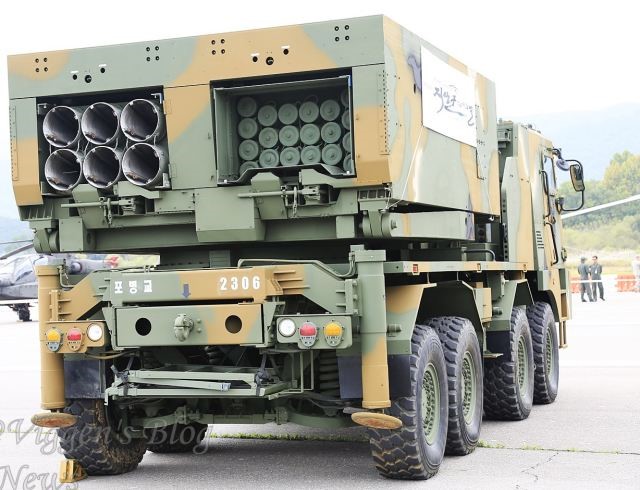
This photo clearly demonstrates the ability of the system to carry rocket pods of varying caliber. This MLRS vehicle is equipped with both 227mm. and 130mm. rockets for demonstration purposes.
The Chunmoo consists of an 8×8 high mobility truck chassis with an armored cab that provides protection against small arms and shell splinters, and a rotating rocket launcher that accepts two rocket pods. These rocket pods differ in size and capacity based on the ordinance that they carry. The MLRS pods are pre-loaded and factory-sealed, and can be stored long term. The Chunmoo can fire any rockets currently utilized by the U.S. Army MLRS and HIMARS systems, as well as the K136 Kooryong 130mm. rocket. Depending on the ordinance, the effective firing range of the Chunmoo is between 45km. (28 miles) and 300kms. (186 miles). The Chunmoo is seen as a key tool in countering and suppressing North Korean artillery batteries.
Air Power
The technological disparity in the weapons systems of the respective ground forces of the DPRK and ROK is dwarfed by the disparity among the air forces of the two nations. Where the overwhelming majority of the DPRK’s aircraft were designed and manufactured in the 1950s and 1960s, the air force of the ROK is equipped with modern aircraft, complete with an air superiority and attack component comprised solely of four generation machines. On paper, the number of aircraft possessed by North Korea looks large, but the reality paints a far different picture. Of far greater importance is the minuscule amount of flight time logged by pilots of the KPA Air Force in comparison to their adversaries south of the 38th parallel. Even if the North Korean fighter pilots had more modern and capable aircraft at their disposal, their lack of flight time and realistic training would put them at an insurmountable disadvantage in any theoretical engagement with the fighter pilots of the ROKAF. Pyongyang’s air force is a paper tiger.
DPRK Air Force
It is often touted that North Korea can rely on 800 combat aircraft in any military confrontation with Seoul; however, this number is misleading and does not give an accurate picture of Pyongyang’s utter impotence in airpower compared to the ROK. Very few of the North’s fighters and attack aircraft are modern designs, capable of succeeding in air combat engagements with the F-15s and F-16s of the ROK Air Force, nor are many of them even airworthy. The poor economic situation of North Korea, caused by both international sanctions and the inherent failures of a totalitarian communist system, have made it virtually impossible for the regime to maintain a high percentage of its combat aircraft, nor provide its pilots with the necessary flight time and training to give them a competitive edge in real combat, especially when one considers the handicap they are expected to overcome. Out of the 800 combat aircraft, only a small number of Soviet designs purchased in the 1970s and 1980s have any chance of surviving in modern air combat.
Fighters/Attack Aircraft
The KPA Air Force possesses a handful of Mig-29s, Mig-23s, and Su-25s. In addition, there are at least 60 Mig 21s and another 120 Chengdu J-7s, which is basically a license built Chinese version of the Mig-21. The most capable ground attack aircraft are the 35 Su-25s and 105 Mig23s that the DPRK is known to possess. The balance of the total fighter and attack inventory is made up of antiquated Soviet and Chinese produced variants of the Mig-17, Mig19, and Su-7.
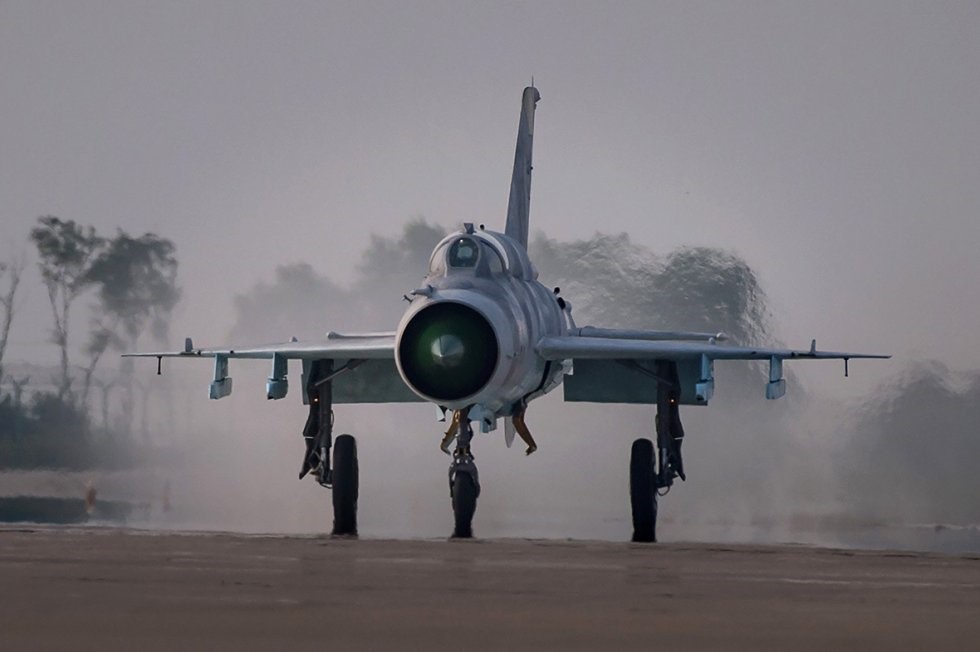
Korean Peoples’ Air Force Mig-21 prepares for take-off. This is the most numerous operational fighter aircraft fielded by North Korea.
Much has been written about the small contingent of North Korean Mig-29 Fulcrums that perform air combat patrols over North Korea, but very little is actually known about their state of operability or readiness. The total number of Mig-29s in the KPA Air Force is often quoted as 40 aircraft, but in reality only 12 to 15 of these aircraft are operational. The first batch of 13 Mig-29As and one Mig-29B were supplied by the Soviet Union between 1988 and 1992. A second batch of Mig29Cs were delivered in “Semi-Knockdown Kits (SKDs)” and were meant to be the nucleus of an indigenous aircraft manufacturing program that would produce Mig-29s in North Korea; however, the plan proved to be beyond the capabilities of North Korean industry. In the end, only 3 more Mig-29Cs were able to be constructed from the SKDs delivered (perhaps enough for ten aircraft), bringing the total up to only 17 operational examples. Spare parts for the planes are made available by the remainder of the unassembled SKDs and a shipment of spare parts supplied by Russia in 1999.
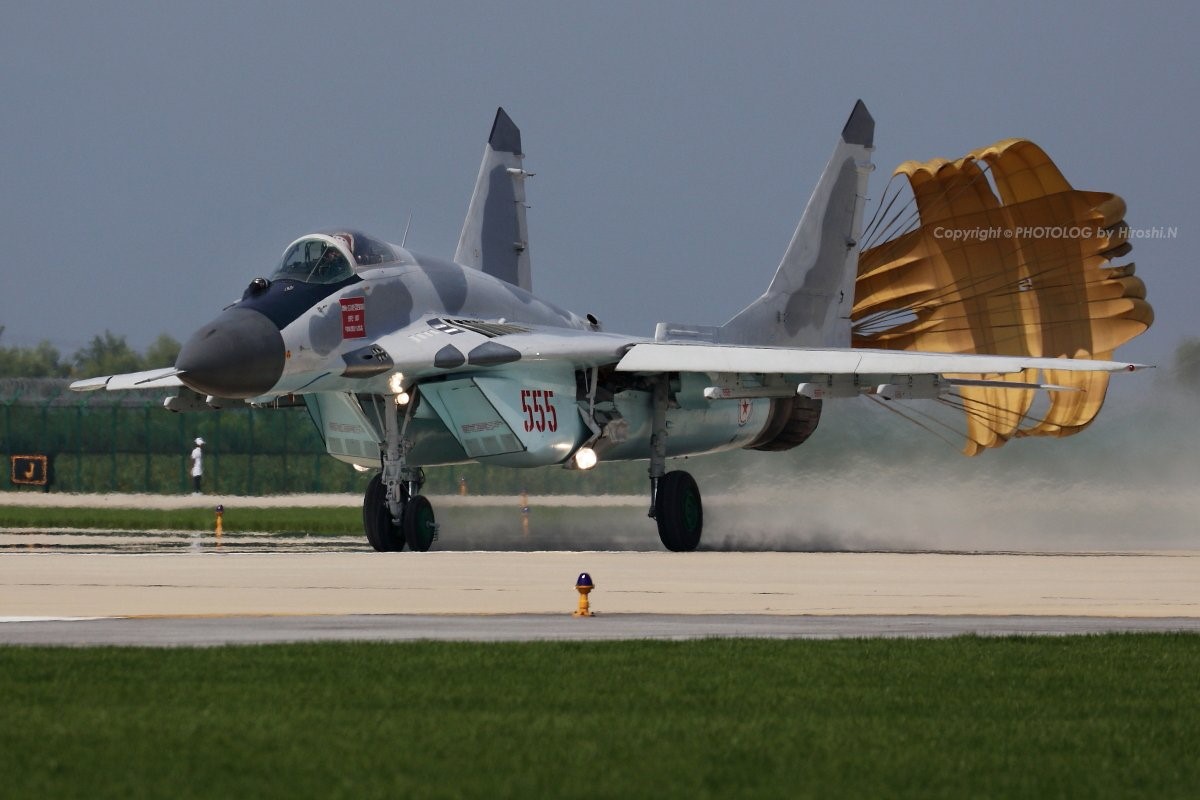
North Korean Mig-29 landing after a flight demonstration conducted at the airshow held at Kalma International Airport in Wonsan, North Korea in September of 2016.
Tactical Bomber Aircraft
The KPAF still operates two regiments of IL-28 and H-5 tactical bombers. The Soviet Union supplied North Korea with 24 IL-28s in the late 1960s, while China later supplied additional H-5 bombers, which are unlicensed analogs of the IL-28. It is thought that the KPAF had as many as 80 of these tactical bombers operational in past decades, but analysts are unsure how many units are still serviceable.
In addition to the older twin engine bombers, the more than 100 Mig-23s in the KPAF can also act as light tactical bombers, performing bombing missions at high altitude to minimize the threat posed by AA artillery and SAMs, as has been the case with Syrian Air Force Mig-23s in the conflict raging in that country. A number of Mig-23s have been lost to ground fire and MANPADS in Syria over the past five years. The Mig-23 is not seen as a very successful aircraft design, and was not a notable improvement over the Mig-21 in many respects, although a few national air forces of former Soviet Republics, African and Middle Eastern countries still operate the aircraft in frontline service.
Ground Attack/Close Air Support (CAS)
Although the KPAF still operates 28 Su-7BMK fighter-bombers, the only modern fixed-wing ground attack aircraft in service are 36 Su-25s. The 36 aircraft are based at Sunchon Airbase near Pyongyang, and consist of 32 single seat Su-25Ks and 4 twin seat Su-25UBKs trainer aircraft. Although the Su-25 first entered service with the Soviet Union in 1978, it is still widely used the world over and is valued for its ruggedness and reliability. The Russian Aerospace Forces have used updated variants of the Su-25 to great effect in combat operations in Syria.
Helicopters
Surprisingly, the DPRK makes use of both Soviet and U.S. manufactured helicopters. The KPAF uses the venerable Mi-2 and Mi-8 transport helicopters for movement of troops and equipment, while the Mi-25 (export version of the Mi-24 Hind) is the primary attack helicopter, which has the same principle characteristics of the Mi-24D. Approximately 50 Mi-25 Hinds are operated by the KPAF, representing a force that will greatly aid in repelling any offensive incursions by the ROK, or supporting ground forces hoping to assault across the DMZ. Once again, the combat effectiveness of North Korean Hinds will largely be determined by the skill of their pilots. Where highly trained Russian aircrews have shown that they can use the gunship to great effect on the modern battlefield, most recently and dramatically in Syria, the pilots of the KPAF would be hard pressed to mirror their exploits.
In an interesting act of arms trafficking and espionage, the DPRK was able to arrange for the purchase and shipment of 87 U.S. made Boeing MD 500D and E model helicopters between 1984 and 1985. Two American businessmen, using a German based firm as a front, were able to circumvent U.S. arms control laws to make good on the deal, and once caught, only served a short prison sentence of 6 months. The 87 helicopters are small and lack any armor protection, but they can carry out aerial reconnaissance missions, act as scouts, or even be outfitted as anti-personnel gunships with the provision of machine guns and rocket pods. It is also surmised that some have been used to insert and extract special operations forces and clandestine operatives in the past, having been painted and marked to appear as MD500s used by the ROK armed forces.
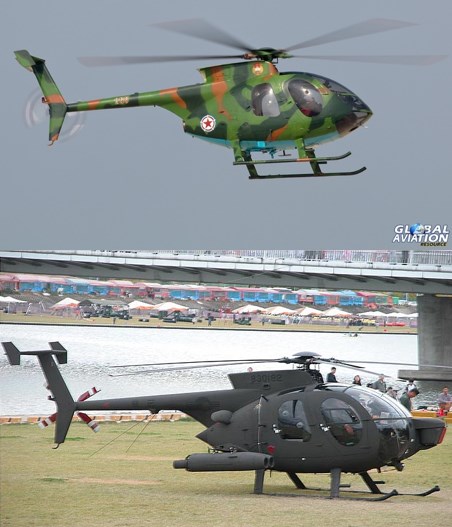
North Korean Boeing MD500 (top) and South Korean MD500 Defender (bottom) equipped with TOW ATGMs.
ROK Air Force
The ROK Air Force is a truly modern air force, equipped with fourth generation fighter and attack aircraft, as well as modern transport, support, and airborne early warning and control (AEW&C) aircraft. The ROKAF is currently in the process of acquiring aerial refueling tankers to increase the range and endurance of its combat aircraft. In line with the South Korean commitment to become militarily self-reliant, the ROKAF began an ambitious program to produce its own supersonic ground attack and advanced jet trainer in 1992. The program lead to the T/F-50 series aircraft, which first entered serial production in 2003. The advanced jet trainer eventually led to the FA-50 light multirole aircraft which is not only fielded by the ROKAF, but has also attracted international buyers.
Air Superiority/Multi-Role Aircraft
While the DPRK relies on fighter aircraft that have not been upgraded since they were first produced in the 1960s, with the exception of a handful of Mig-29s, the ROKAF has upgraded its air superiority and attack aircraft repeatedly since the cessation of the Korean War. The F-5s and F-4s that were the mainstay of the ROKAF have gradually been replaced by the F-15K (ROK equivalent of the F-15E) and the F-16C in frontline service. The all new, indigenously produced FA-50 is gradually supplementing these proven workhorses as the mainstay of South Korea’s combat aircraft over the next decade. An order for 40 F-35 Lightning IIs has also been placed with Lockheed Martin for delivery of the controversial and flawed fifth generation fighter at some point in the future, if the aircraft ever achieves operational status in the United States.
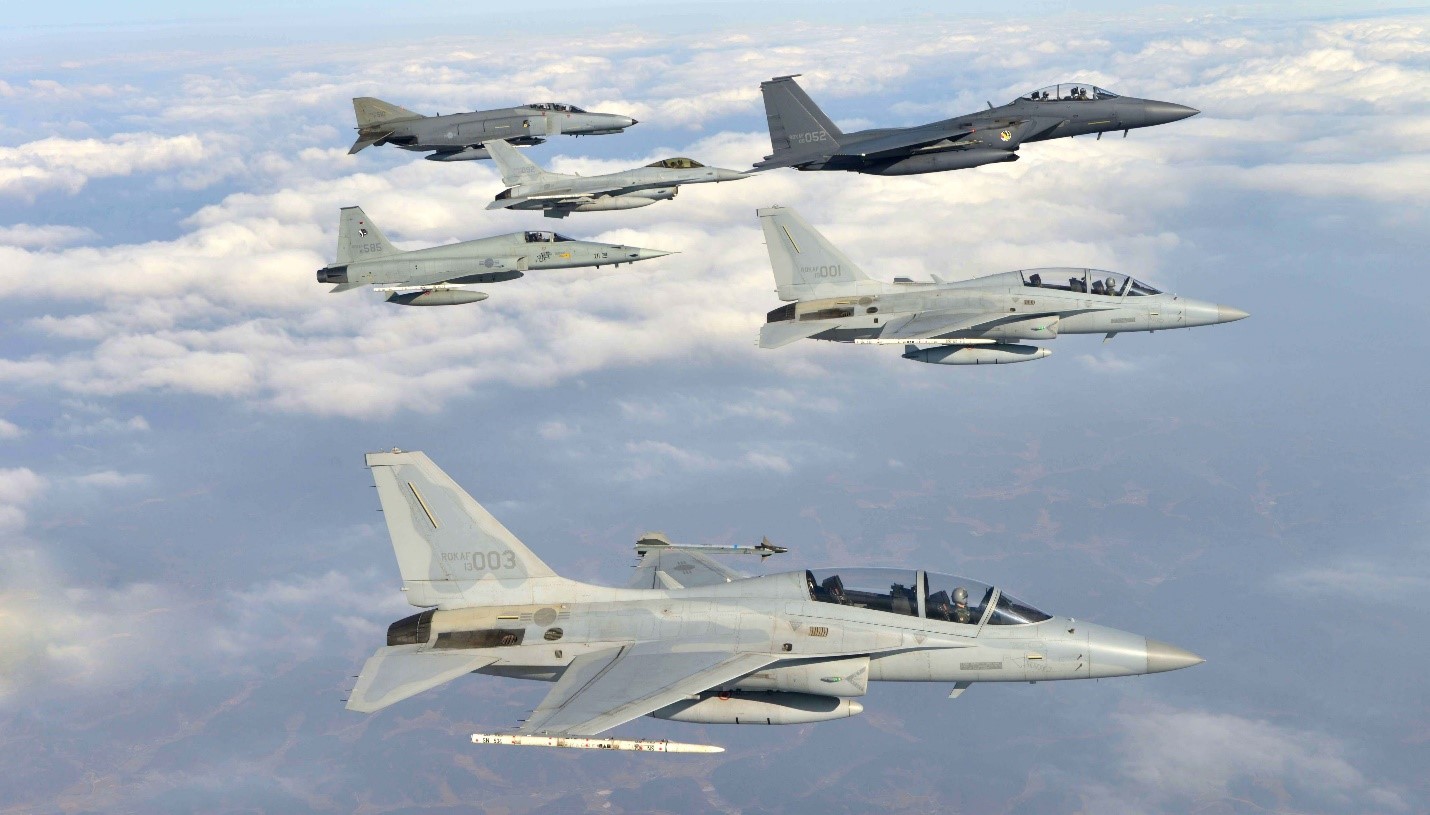
ROK air superiority and multirole combat aircraft from left to right: F-4E Phantom II (retired), F-16C Falcon, F-5E Tiger II (retired), two FA-50 Fighting Eagles, and F-15K Falcon.
The TA-50/FA-50 supersonic jet trainer and multirole combat aircraft was indigenously designed and manufactured by Korea Aerospace Industries (KAI). Envisioned in the 1990s, the aircraft was brought to fruition by a partnership between KAI and Lockheed Martin. The airframe shares a number of similarities with the F-16, and indeed has proven a good training platform to prepare young pilots for flying the F-16 and F-15 fighters when they are assigned to combat units. The TA-50 (trainer) was soon developed into the FA-50, a light, multirole combat aircraft that can engage both aerial and ground targets with a mix of ordinance. The lower cost of procurement and operation of the smaller aircraft soon gained the attention of other Asian nations, who saw the jet as a good alternative to more costly U.S. and European combat aircraft. The Philippine Air Force operates 12 FA-50s, two of which first saw combat in an airstrike on Islamist militants on the island of Mindanao in January of 2017. Both Indonesia and Thailand have purchased the TA-50 to replace older trainers, and the Iraqi Air Force is slated to receive 24 FA-50s by the end of 2017.
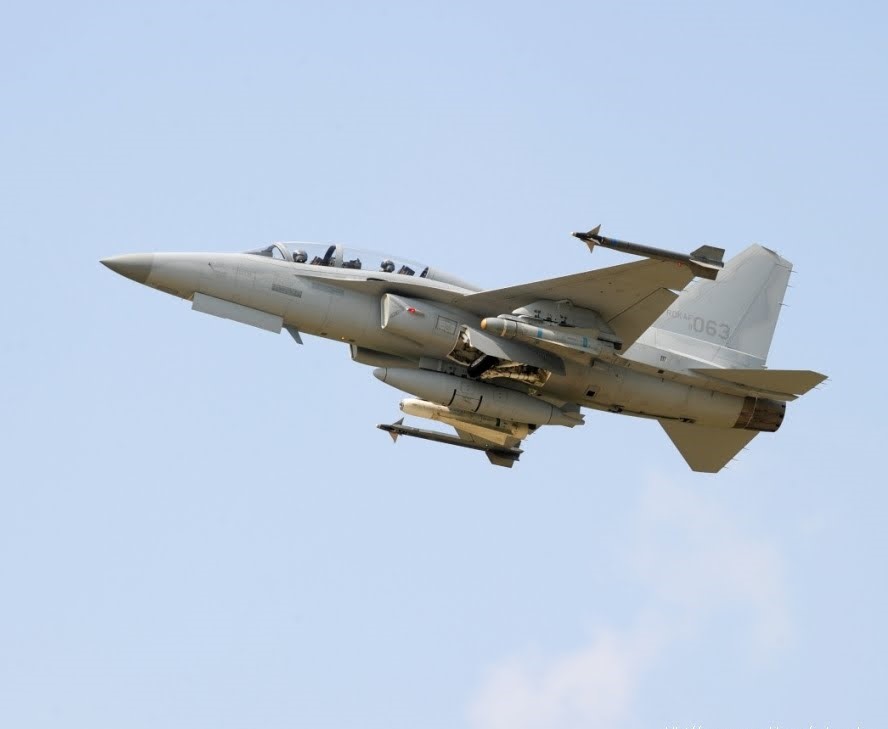
FA-50 of the ROKAF armed with AIM-9 Sidewinder missiles for air-to-air engagement, a pair of AGM-65 Maverick air-to-ground missiles, and an external drop-tank of fuel for added range. This aircraft has two additional underwing hardpoints left unutilized in this configuration. Total payload is 3,740kg. (8,250lb.).
Envisioning a new, indigenously produced aircraft to replace the current F-16C, which is the backbone of the ROK fighter force, the “KF-X Future Fighter Program” was first envisioned in the early 2000s and has evolved considerably since that time. The government of Indonesia is a partner in the project as of 2010, helping to fund research and development and the creation of a prototype aircraft. Some analysts have described the new aircraft as similar to the Eurofighter Typhoon design, with added stealth technology. Regardless of the successful progression of the KF-X project, the 168 F-16Cs of the ROKAF present a considerable advantage over any of the aircraft that the North possesses.
Ground Attack and Close Air Support (CAS)
The ROKAF does not operate a dedicated ground-attack aircraft and instead relies on its multirole aircraft describes above to support ground operations with airstrikes as required. The U.S. Air Force has at least 25 A-10 Thunderbolt II ground attack/CAS aircraft with the 51st Operations Group based at Osan Airbase. Without a doubt, the A-10 is the most capable dedicated ground attack aircraft in the world, armed with the GAU-8 30mm rotary cannon and a payload of 7,260kg. (16,000lb.), and with a total of 11 hardpoints to deploy a wide range of ordinance.
Airborne Early Warning and Control (AEW&C)
Four Boeing 737 AEW&C E7A Peace Eye aircraft were purchased by the ROK as part of a contract signed with Boeing in 2006. The aircraft were all delivered to the ROKAF between 2011 and 2012 after an extensive refit/modification by KAI in South Korea. The AEW&C aircraft are a critical force multiplier for the ROK Armed Forces, who are facing a numerically superior adversary. Not only can the Peace Eye detect airborne interdiction by the KPAF into ROK airspace, but they can also monitor all electronic communications of KPA forces and track the movements of enemy units. The large Electronic Systems Multi-role Electronically Scanned Array (MESA) radar with an acquisition/tracking range of approximately 370km.-400km., also has an electronic signals intelligence range in excess of 850km. at an altitude of 9,000 feet. Peace Eye greatly reduces the chances of the KPA exploiting the element of surprise in any planned conventional attack. The North Korean regime lacks any AEW&C capability which represents a major disadvantage in any future conflict.
Helicopters
The ROK Armed Forces operate a mixture of U.S., European and even Russian helicopters. There are three AS332 Super Pumas and five Ch-47 Chinook helicopters for transport, as well as 29 MS-70A (license-built UH-60 Blackhawk) for troop transport. The ROKAF also operates 25 MD500 Defender light attack and scout helicopters. A majority of these have been outfitted as light anti-tank gunships, being equipped with four tow missiles mounted on winglets. Interestingly, the ROK has a small fleet of 7, Russian made Kamov Ka-32 utilized in the role of combat search and rescue (CSAR).
The newest and most capable rotary wing aircraft purchased and deployed by South Korea are the 36 Boeing AH-64E Apache gunships which were delivered in early January of 2017. They have been deployed in two battalions subordinated to the Army Air Operations Command. These helicopters are in addition to the 30 to 48 AH-64Ds operated by the U.S. Army forces based in South Korea on a rotational basis. The AH-64D has largely replaced the OH58D Keowa scout/light attack helicopters that the U.S. Army had stationed on the Peninsula. The Apache is a much more capable and suitable attack aircraft considering the large numbers of tanks and armored vehicles that would likely spearhead any North Korean military assault.
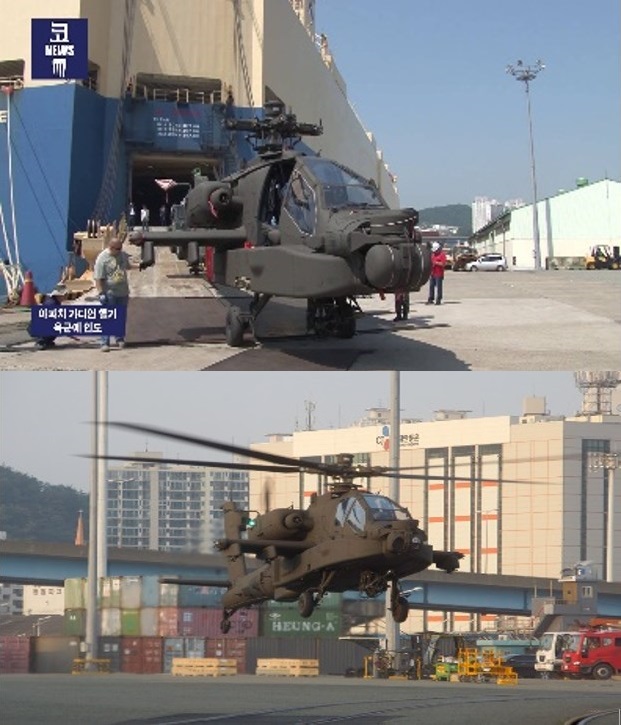
The first of 36 AH-64E Apache Guardians were offloaded in the Port of Pusan in January, 2017. Their main rotor blades were reassembled on the dock and the helicopters were flown straight to a military air field.
Navies
The navies of the two nations are structured so differently, that it is hard to conduct a side-by-side comparison. The North Korean navy has no surface warfare vessels that are of significant tonnage, nor can compare technologically with a truly modern navy. The navy operates many vessels, but most of them are old and antiquated, small in displacement, or rely on stealth to have any hope of surviving any limited, let alone major conflict. For example, the Korean Peoples’ Navy allegedly operates 70 submarines; however, the majority of these vessels are of old Soviet design or are locally produced coastal or midget submarines of dubious value. The large fleet of old amphibious landing ships, the majority of which were built in the 1950s and 1960s, would be hard pressed to survive long enough to beach and discharge their payload of troops and equipment. Without a viable air force and capitol ships to defend these landing craft, there is little probability that the DPRK could use them in an amphibious operation against the territory of South Korea with any hope of success.
The South Korean Navy by contrast, operates a well-balanced, modern and capable fleet of large surface combatants, amphibious assault vessels, and support craft that represent a true blue water navy. A number of these vessels are among the most advanced and capable warships in the world. The South Korean shipbuilding industry is one of the most capable in the world, and only China produces more total vessels than South Korea, with Japan a very close third place contender. Companies such as Hyundai Heavy Industries, Daewoo Ship Building and Engineering, and Samsung Heavy Industries have been at the forefront of maritime design and construction for at least 30 years. This expertise in commercial shipbuilding has logically carried over into naval vessels.
DPRK Navy
The Korean Peoples’ Navy is considered a brown water navy, as it lacks any large vessels with the displacement and endurance to project any amount of power far from North Korean shores. The largest vessels in the KPN are a handful of frigates and light frigates (corvettes by modern naval standards). The majority of hulls of the KPA are comprised of small patrol boats, antiquated landing craft of small displacement, and a large number of outdated diesel electric submarines and midget submarines. Although these subs have proven quite effective over the years in inserting and recovering teams of commandos and clandestine operatives into South Korea, there strategic value is questionable. They have limited range, are very small in size, lack modern weaponry, and are far louder than newer submarines in service with the navies of South Korea, Japan, China and the United States.
Frigates and Light Frigates
The largest vessels in the KPN are two Najin Class frigates which are of North Korean design and manufacture. One of these vessels (Hull # 631) has been receiving a major modernization refit at a shipyard in Nampo. After approximately a year and a half of maintenance and refit, Najin #631 appears to have had its main radar and fire-control radar upgraded, older manually loaded gun armaments aft removed, and the provision of more modern KH-35 anti-ship missiles (ASM) amidships, in four racks of two missiles each. There are also two close-in defense cannon turrets located astern, both port and starboard, which are probably indigenous analogs of the Russian AK-630 CIWS.
Two light helicopter carrying frigates have been added to the navy, with satellite imagery documenting their building in the ports of Nampo on the east coast of North Korea and Najin on the west coast. Although little is known about the new vessels, a number of key characteristics can be extrapolated from imagery. The vessels appear to be small in displacement, at between 1,300 and 1,600 tons, have an LOA of 75 meters, and a Beam of 11 meters. The vessels have a large helicopter deck located aft, and possibly hangar space located just forward of the flight deck, sharing space with the superstructure. Armament compliment is still unclear, but there appear to be RBU-1200 anti-submarine rocket launchers mounted forward of the superstructure. There are most likely some short range surface-to-air missiles and a small number of KH-35 ASMs incorporated in the design. Although not visible in satellite imagery, it would be reasonable to assume that the vessel is also equipped with the same North Korean version of the Russian AK-630 30mm rotary cannons for close-in defense. These vessels are mostly medium endurance anti-submarine warfare (ASW) vessels built to provide added ASW capability to the KPN as South Korea continues to add advanced, German designed diesel electric submarines (SSK) to its submarine fleet.
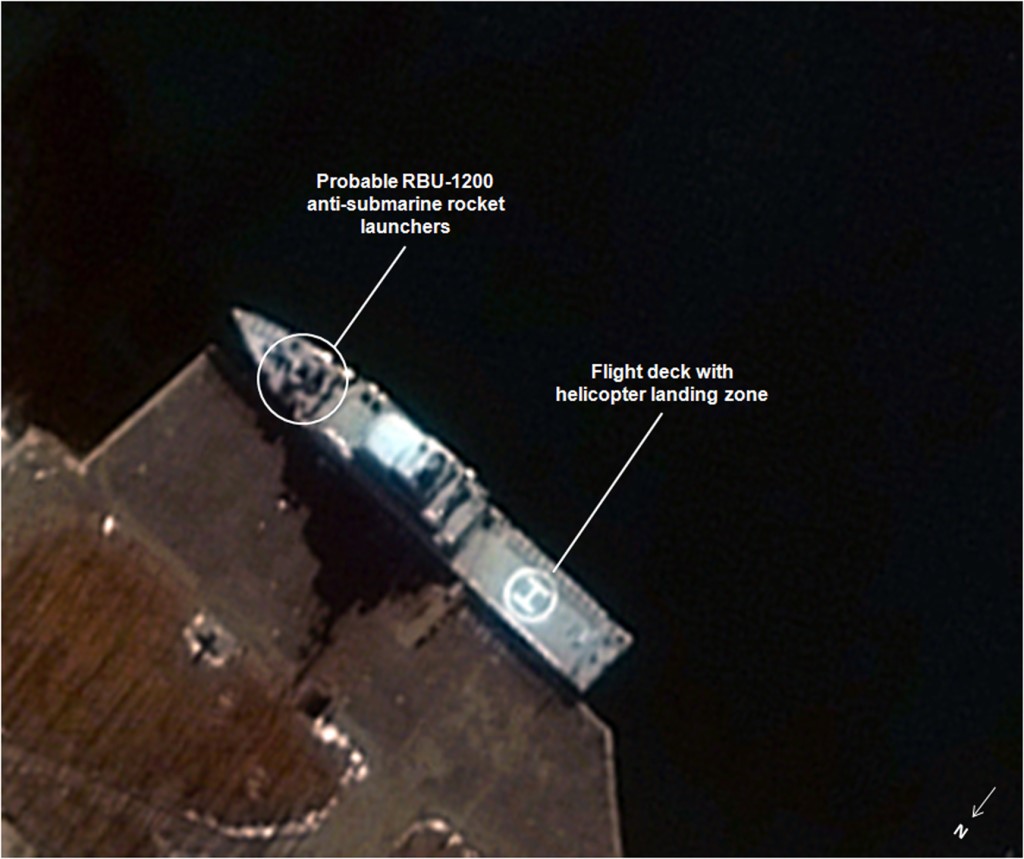
Satellite imagery of an FFH docked at Najin on the North Korean coast adjacent to the Sea of Japan. Little is known about this class of vessel, although images such as the above first became available at the end of 2013.
Submarines
North Korea’s large number of submarines are often touted as a major strategic threat to the maritime security of the South. Much attention is given to the quantity of submarines in service, but apparently little analysis is done concerning the survivability of such an old and antiquated submarine force in any theoretical confrontation with a prospective adversary such as South Korea, Japan or the United States. While all of North Korea’s submarines are based on very old Soviet and Yugoslavian designs that date from the late 1950s and early 1960s, all current boats with the exception of 20 Romeo Class submarines are indigenous designs.
The largest diesel electric attack submarines in the KPN inventory are the 20 Type 033 Chinese manufactured submarines that are copies of Soviet Romeo Class submarines sold to China in the late 1960s. The submarines were sold to North Korea beginning in the early 1970s. China continued to supply components for the Type 033 into the 1990s, helping the DPRK build the submarines in local shipyards. These submarines represent the largest in service with the KPN, displacing approximately 1,500 tons (1,800 tons submerged) and measuring 76 meters LOA. Although they have been continuously updated over their many decades of service, they are of an extremely outdated design, and few modifications can aid in making them run quieter, or increase their range and fuel efficiency. Their only offensive weapons are torpedoes and mines. They lack the ability to fire both SAMs and ASMs while submerged.
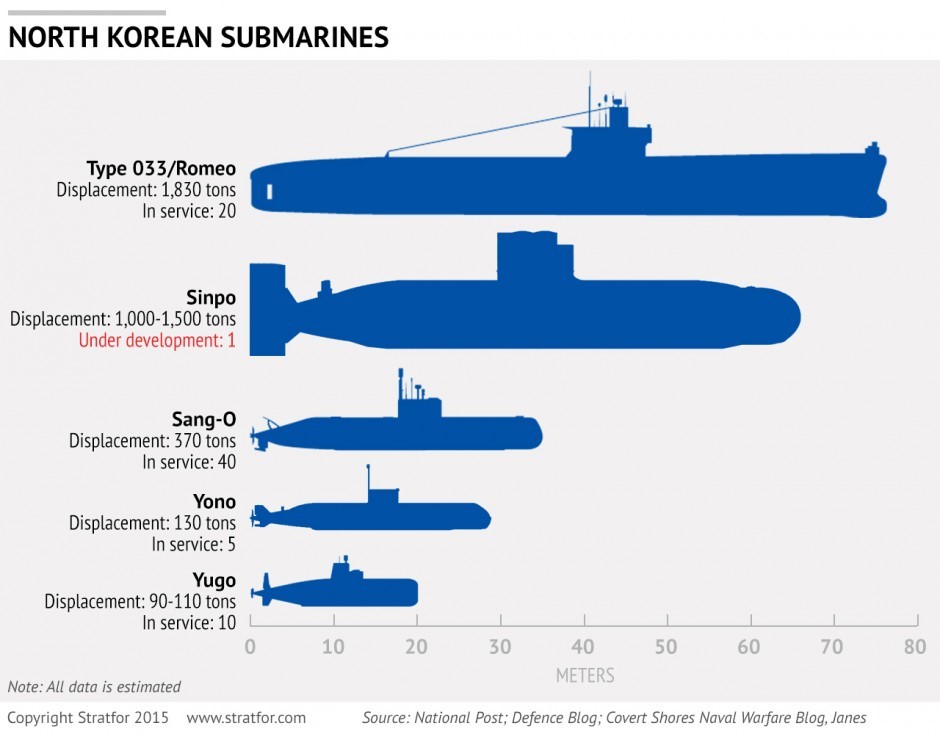
A diagram of the submarines currently in service in the KPN.
The most numerous submarine utilized by the KPN are the Sang-O and Sang-O II Class, with at least 40 in service. The Sang-O is a diesel electric attack sub at 34 meters LOA, and the Sang-O II is an elongated (approximately 40 meters LOA) attack/reconnaissance version of the same submarine that is capable of greater range and can carry special operations forces for clandestine operations. The vessel is equipped with two torpedo tubes which fire the Russian-made 53-65KE torpedo. The submarine is also capable of laying mines. Little was known about the Sang-O class and its capabilities were left up to conjecture until one ran aground in South Korean waters on September 18, 1996 while attempting to extricate a 3 man special operations team meant to conduct reconnaissance of the naval installations on the east coast of South Korea near Gangneung. While returning to extricate the recon team, the submarine ran aground and the crew and special operations soldiers attempted to make their way back to North Korea by land. The resultant 49 day manhunt resulted in many military and civilian deaths and casualties. The submarine was captured and salvaged. This incident was pivotal in discovering the real capabilities of the large KPN submarine force. A thorough study of the submarine revealed that the North Koreans had made use of many “off the shelf” navigation and communications systems, as well as late 1950s and 1960s soviet sonar. The myth of the North Korean submarine fleet was largely dispelled with this incident.
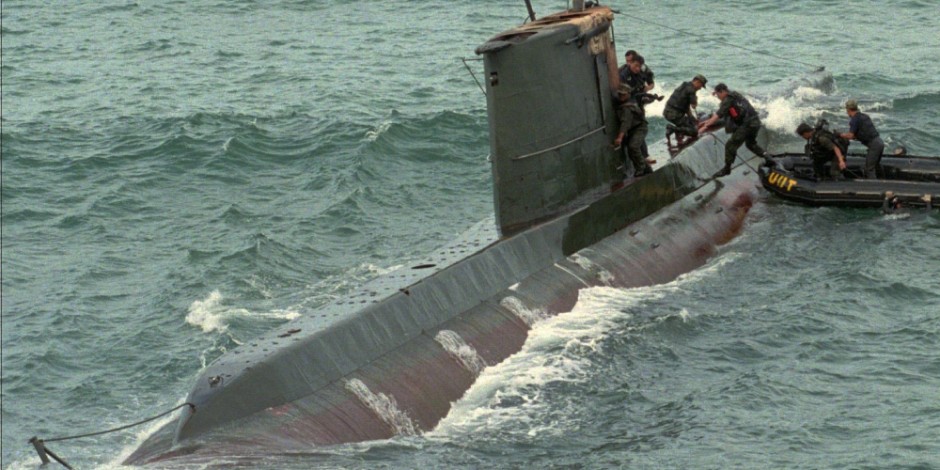
Sang-O submarine that ran aground and was abandoned in 1996 off Gangneung, South Korea. The South Korean boarders in this photo provide a good point of reference in exhibiting the diminutive size of the coastal attack submarine.
Under the direction of Kim Jong-un, North Korea has been concentrating on developing a viable nuclear deterrent. Having developed a nuclear weapon, and most likely already possessing the capability of delivering such a weapon via aircraft or short range ballistic missile, work has apparently been progressing on developing a submarine launched ballistic missile (SLBM) and a submarine that can launch such a missile while submerged. Official recognition of an SLBM program by the government in Pyongyang occurred in May of 2015. A number of failed SLBM launches conducted between May 9th, 2015 and December 21st, 2015 preceded a successful test on August 8th, 2016. The missile was launched while submerged and flew 310 miles before touching down in the Sea of Japan. It cannot be corroborated whether the missile was fired from a submarine, or from a submerged barge. The SLBM that is being developed and tested is called the Bukkeuseong-1, which is based on the Pukguksong KN-11 ballistic missile.
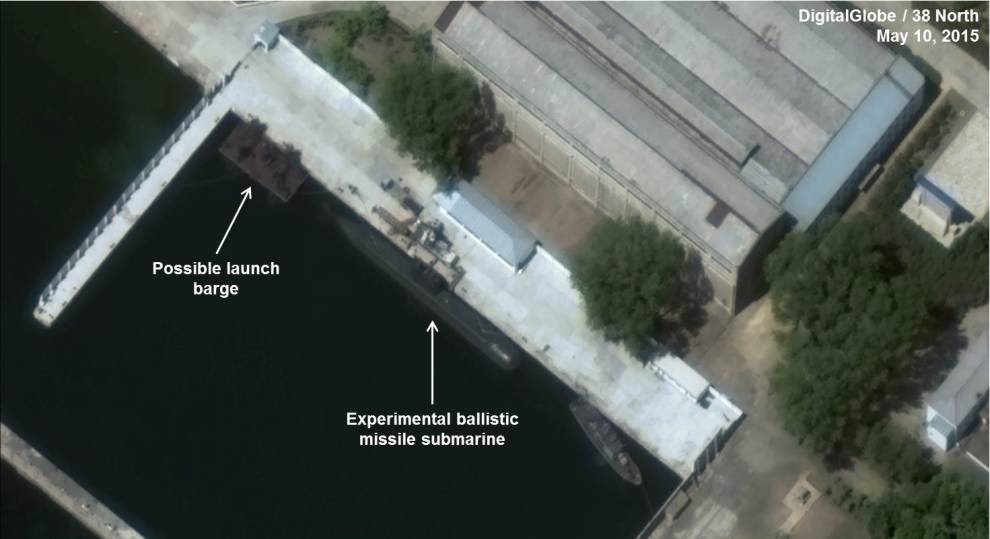
Satellite imagery of the Sinpo South Shipyard SLBM test site in North Korea. Note the submersible launch barge and what appears to be the first Sinpo Class (Gorae) SSB. Whether this submarine is capable of being armed with an SLBM is very much in doubt.
There is currently one new class of submarine that has been observed at the Sinpo South Shipyard associated with the SLBM development program. This submarine is larger than the Sang-O, yet smaller than the Type 033/Romeo submarines currently in service with the KPN. It has been theorized that this new submarine, dubbed the Sinpo or Gorae Class, is being developed as a ballistic missile submarine (SSB). High resolution satellite imagery appears to show one, or possibly two openings in the after section of the conning tower that may be launch tubes for KN-11 missiles. The small size of the submarine would denote a limited range, surely less than 2,000nm. (3,700km.) which reduces the strategic value of such a platform considerably; however, if it can depart its home port undetected and is stealthy enough to remain undetected at sea, and is capable of launching an SLBM (even if only on the surface), it provides the DPRK a limited retaliatory strike capability. Although very limited, this would represent the third leg of the nuclear triad.
Missile Boat/ Patrol Boat
North Korea operates a force of hundreds of patrol boats to secure the coastline and maritime territory of the country. There are approximately 30 patrol boats armed with anti-ship missiles, and perhaps another 400 or more patrol boats of various size, endurance and armament. These vessels range from old soviet designed boats to new, indigenously created guided missile patrol boats that make use of low radar visibility hull and superstructure design. Perhaps the most capable fast attack craft armed with anti-ship missiles (most likely analogs of the Russian KH-35) are the six Nongo Class vessels. These vessels are similar in design and capability to the Chinese Type 022 Class Houbei guided missile patrol boat.
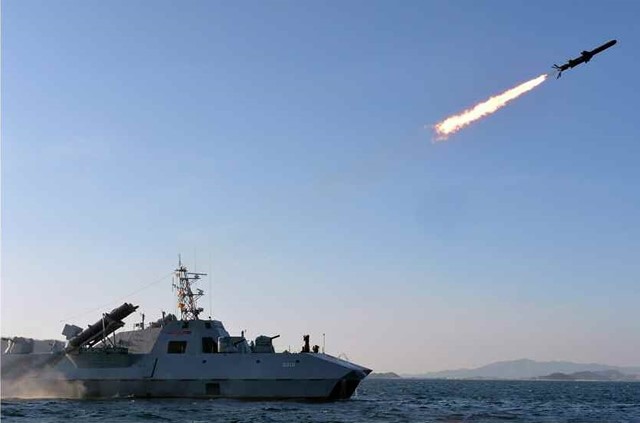
Nongo Class PBG. The KPN currently has 6 of these fast attack vessels in service and will likely be building more in the coming years.
ROK Navy
The ROK Navy has always been qualitatively superior to the Korean People’s Navy; however, it has made major strides since the turn of the 21st Century. Not only has the ROK built six new helicopter carrying destroyers (DDH) since 2003, but they have built an additional three Aegis guided missile destroyers (DDG) and six guided missile frigates (FFG). One large displacement Landing Platform Helicopter (LPH) vessel was completed and commissioned in 2007, the ROKS Dokdo, with one additional sister ship under construction. Two more large amphibious ships have been commissioned between 2014 and 2016, with one more to be commissioned this year and an additional ship planned for construction in the next two years. Eighteen brand new guided missile patrol boats have been commissioned since 2008. No less that nine diesel electric attack submarines have been commissioned into the ROK, three of which are the last three vessels of the KSS-1 project, and the last six are the first of nine submarines planned in the KSS-II program. These submarines are a joint venture between Daewoo Shipbuilding & Engineering (DSME) and Howaldtswerke-Deutsche Werke (HDW) of Germany. Two large salvage and rescue vessels have been built and commissioned to support the expanding submarine force.
Surface Warfare Vessels
When one looks at naval developments in the Asia-Pacific region, it is easy to identify China as the leader in naval modernization and construction over the past decade. The Peoples Liberation Army Navy (PLAN) has grown by leaps and bounds, both in quantitative and qualitative terms. The progress and achievements of South Korea have largely maneuvered out of the shine of the spotlight. This fact, in and of itself, is an added accomplishment. Very few people have taken notice of the naval modernization program embarked upon by South Korea at the beginning of the century. The ROK decided upon a self-reliant “Made in Korea” defense policy in general, but they also decided that they would need to sink or swim when it came to meeting security challenges on the high seas and defending the maritime territory of the nation.
In a concerted effort to meet the maritime security challenges of the Korean Peninsula and the East China Sea as Kim Jong-un has aggressively moved to develop a nuclear equipped ballistic missile and Japan has reasserted its claim of sovereignty over small islands that South Korea sees as its own, the decision was made to modernize the ROK Navy from top to bottom. Beginning in the year 2000, South Korea began construction of newly designed surface warfare vessels. The cap stone of these new ships are the three Aegis equipped DDGs know as the Sejong the Great Class. These vessels are comparable to the U.S. Arleigh Burke Flight II and the Japanese Atago Class in most respects. They have an 11,000 ton displacement when fully loaded, have an LOA of 165 meters and an effective operating range of at least 5,500 nautical miles. They are equipped with two Mk41 VLS, with one 80 cell unit forward, and on 48 cell unit aft of the main superstructure. They carry a full range of ASW and AAW weapons systems, as well as anti-ship guided missiles that are utilized in the Mk41 VLS. The decision to equip the DDGs with the SM-3 anti-ballistic missile is currently under discussion and will most likely be approved to counter the growing ballistic missile threat from the North. Three additional vessels of this class are to be built over the next five years.
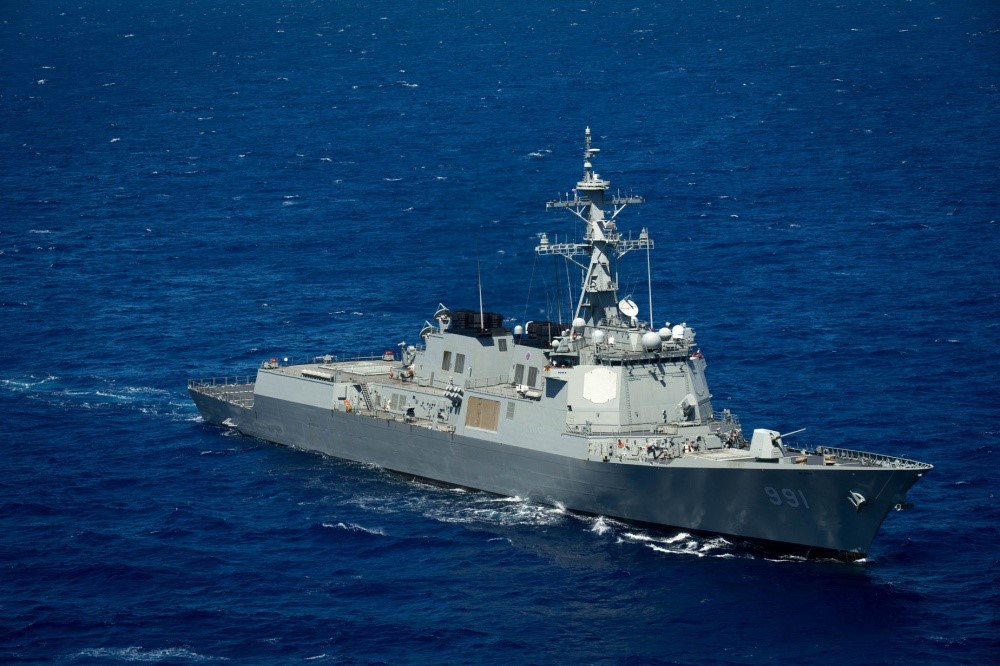
The Sejong the Great Class bears a striking resemblance to other Aegis DDGs. In addition to its many defensive and offensive weapons systems, it has an aft mounted flight deck and hangar space to accommodate two helicopters for transport and ASW duties.
In addition to the new DDGs, the ROKN has taken delivery of six general purpose destroyers between 2003 and 2008. The vessels are known as the Chungmugong Yi Sun-shin Class and measure 150m. LOA, with a loaded displacement of approximately 5,500 tons. They are classified as helicopter carrying destroyers (DDH). These vessels have a very well balanced offensive and defensive weapons package, including a 32 cell Mk41 VLS, 76mm deck gun, 8 Harpoon anti-ship missiles, two triple launchers for 324mm torpedoes, and a 30mm Goalkeeper CIWS. Each vessel is equipped with an aft flight deck and hangar space for two Super Lynx helicopters.
The Future Frigate Experimental (FFX) program was launched in the early 2000s to procure a new generation of flexible coastal defense frigates to replace other aging fleet vessels. The resultant Incheon Class frigates are not only armed for surface warfare and ASW tasks, but can also strike inland targets with the newly adopted Tactical Ship to Land Attack Missile, and its large caliber 127mm/L62 Mk.45 deck gun. A further six vessels are to be built (bringing the total to 12 FFGs) with a number of weapons modifications and upgrades, including the provision of a 16 cell K-VLS (South Korean manufactured version of the Mk.41) equipped with land attack cruise missiles (LACM).
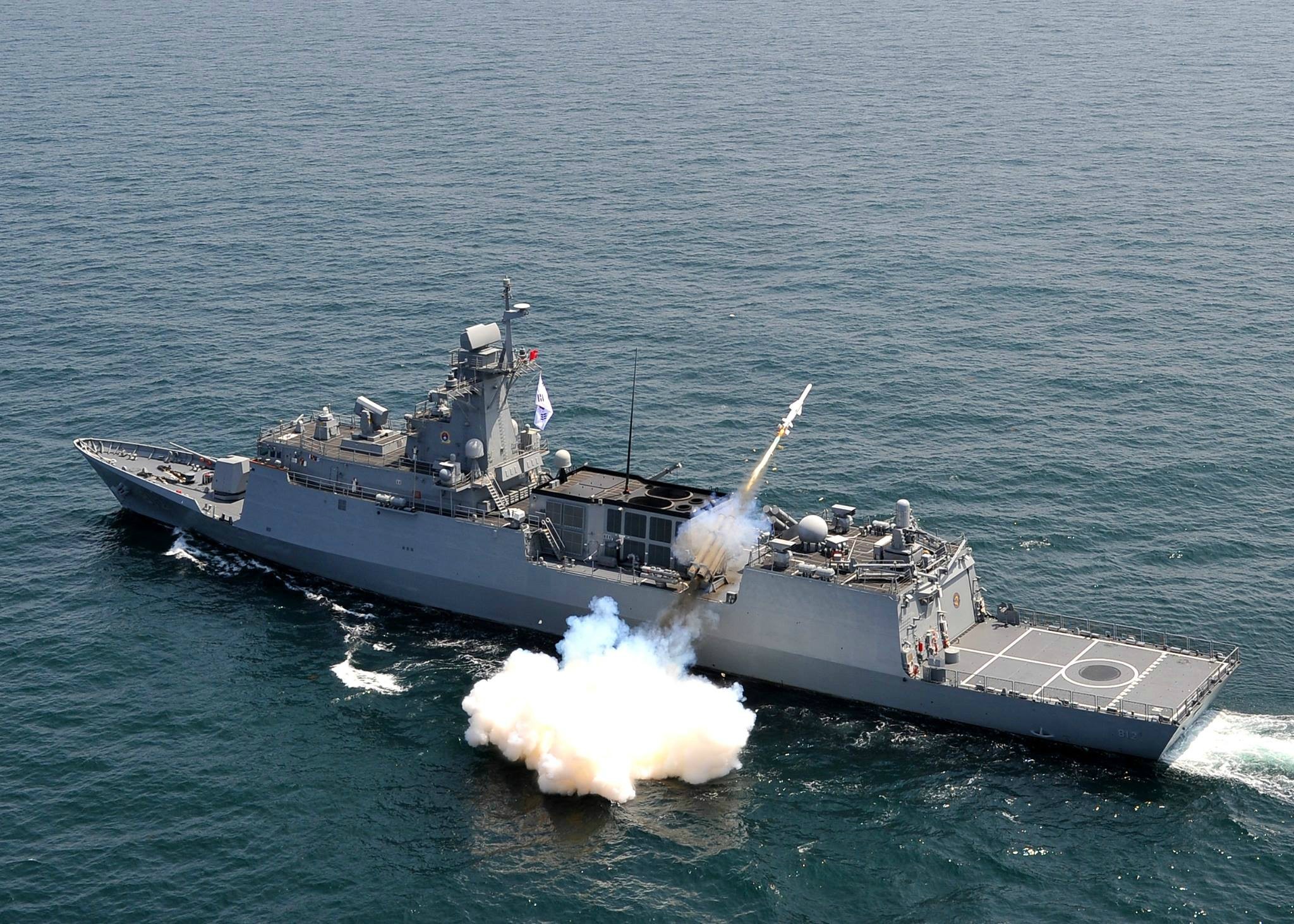
Incheon Class frigate firing a Hae Sung (Sea Star) SSM-700K anti-ship missile from its port side quad launcher.
Amphibious Warfare
In contrast to the DPRK, which has not upgraded its amphibious warfare capabilities in 50 years, the ROK has made the decision to add a number of capable new vessels, giving it greater strategic options and flexibility in the realm of amphibious operations. Like most nations around the world that have a viable naval force presence, they have seen the benefits inherent in a multi-purpose naval platform such as an LHD or LPD. The Dokdo Class Landing Platform Helicopter (LPH) is a large amphibious warfare ship that can perform a number of functions, from launching air assault and amphibious assaults, to launching VSTOL aircraft (South Korea has ordered 40 F-35 JSFs) and serving as a command ship. A second Dokdo Class LPH is currently under construction. In addition, four Go Jun Bong Class Landing Ship Tank (LST) were constructed in the 1990s to replace aging landing ships, and three Cheon Wang Bong LSTs have been built in the last three years, with a fourth currently under construction.
Originally planned to encompass three in class, the Dokdo Class LPHs are large multi-role naval platforms that can perform a range of vital functions. Similar in design and displacement as the JMSDF Izumo and Hyuga Class DDH vessels, the ROKN vessel has the added operational flexibility of a well deck. The Dokdo has an LOA of 199 meters (653 ft.) and a loaded displacement of 18,800 tons. With over 100,000sqft. of deck space and five helicopter spots, the Dokdo can conduct efficient helicopter assault and HADR rescue operations. The flight deck is reinforced and heat shielded, allowing for modern VSTOL operations. There is ample space to utilize the V-22 Osprey tilt-rotor aircraft, which requires more space than traditional rotary-wing aircraft. The well-deck can launch and recover LCACs, LCMs, or AAVs. Accommodation of a full battalion of ROK Marines (700-720 men) and all of their equipment is provided, as well as heavy vehicle and equipment storage. Two LCACs and 7 AAVs are stowed onboard to facilitate amphibious assaults, and 10 K1A1 MBTs, a battery of artillery and light vehicles are stowed in the vehicle deck. The vessel also has a fully equipped hospital to handle battlefield casualties or to treat victims of man-made or natural disasters.
The ROK Navy began modernizing its fleet of large landing ships in the 1990s, with the LST-1 program. Four LST-1 vessels were built over a five year period between 1994 and 1999. These Go Jun Bong Class LSTs are tradition landing ships that beach bow-first to discharge vehicles and assault troops via a bow ramp. The vessels are 124 meters LOA, and have a loaded displacement of 4,400 tons. Each ship can carry 250-300 marines, 10 MBTs or 14 AAV7s and 8 2.5 ton utility trucks. The vessels also have an aft flight deck for operating a UH-60 helicopter.
The next generation of modern LST-II vessels began construction in 2013, and three out of four have been commissioned. The fourth and final vessel of the Cheon Wang Bong Class LSTs is scheduled to be completed sometime in 2018. Although classified as an LST, the Cheon Wang Bong Class vessels are unconventional in design and more closely resemble a commercial RoRo vessel that discharges cargo via a stern ramp and side ramp, and handles vehicles internally via a number of hydraulic elevators and a central turn-table. Each vessel also stows two large landing craft on the weather deck forward of the superstructure. These LCMs are lifted/lowered into the water via a large hydraulic deck crane. In most respects, the Cheon Wang Bong LSTs operate like a landing platform dock (LPD). Each vessel can accommodate 700 troops and their equipment, including MBTs and light vehicles. The vessels have a large aft flight deck that can handle two UH-60 helicopters at the same time.
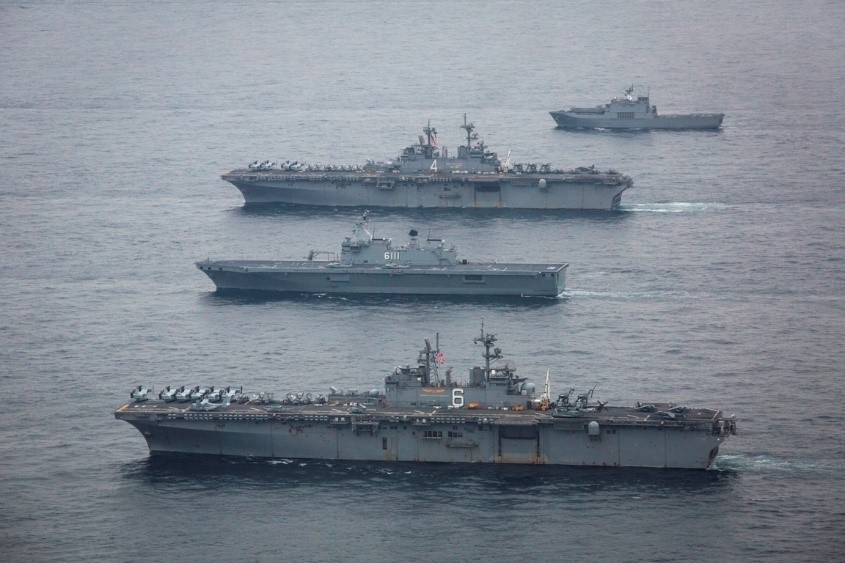
U.S. Navy amphibious warfare vessels USS Boxer (LHD-4) and USS Bonhomme Richard (LHD-6), and ROK Navy vessel Dokdo (LPH-6111) and Cheon Wang Bong (LST-686) during the “Ssang Yong 2016” Exercise.
The DPRK Nuclear Program
After reviewing the comparative strengths and weaknesses of the conventional military capabilities of each state, it is easy to come to at least two separate conclusions. Firstly, any conventional war waged between the two Korean nations would be a horribly tragic event, the human and material toll of which is hard to imagine. Millions would be killed, the infrastructure of both nations would be destroyed, and the militaries of Japan, China and the United States would most likely be drawn into the conflict, which would expand into a wider war. Such a war is not in the interests of any of the parties listed above, chief amongst them North Korea and South Korea. For decades, a clearly established balance of power was maintained between a militarily strong Pyongyang north of the 38th parallel, and the weaker Seoul government backed by a powerful United States to the south. This conventional balance of power has slowly, yet inexorably, shifted since the cessation of hostilities in 1953.
Kim Jong-il obviously hypothesized that the growing disparity in conventional warfighting capabilities between the two Koreas that began in the 1990s would lead to an insurmountable handicap for the DPRK and began the rational strategy of seeking an unconventional deterrent as the only viable solution to bringing the scales back into balance. As South Korea continued along its path to becoming a global economic powerhouse, its defense subsidized militarily by the U.S., the extremely archaic communist northern state could not hope to out-match it in defense acquisitions and technological developments. A viable nuclear deterrent was seen as the only long-term option in maintaining the balance of power on the Korean peninsula and preserving the communist regime.
The situation is further complicated by the fact that neither the United States nor China desire a peaceful reunification of the Korean people. It is seen as strategically beneficial in the eyes of the Chinese government to maintain a geographical buffer between itself and the U.S. aligned powers of South Korea and Japan in the region. The United States desires a reunification of the Koreas only on its terms, with any reunification leading to a U.S. aligned state. Any official peace treaty resulting in two reconciled, yet independent states is an unacceptable scenario for Washington. An interesting case study in political pragmatism is evident in the changing relationship of Russia with both North and South Korea. Russia maintains beneficial economic ties and cordial political interaction with both states. Russia’s pragmatic approach to international relations has all too often fallen prey to greater, competing geo-political forces. In the case of the Koreas, it has so far been successful.
The origins of the North Korean nuclear weapons program date back prior to the Korean War; however, major strides were made under the direction of Kim Jong-il in the 1990s and early 2000s, before his death in 2011. The DPRK exploded their first nuclear weapon in 2006, and followed up with nuclear weapons tests in 2009, 2013, and two tests in 2016. Kim Jong-un has aggressively pursued developing a compact nuclear weapon that can be miniaturized enough to be housed in a ballistic missile warhead. North Korea’s nuclear program has produced enriched plutonium and uranium; however, it is unclear if the uranium enrichment has progressed far enough to produce weapons grade nuclear material.
The six party talks aimed at maintaining a denuclearized Korean peninsula, which began in 2003, were suspended in 2009 as negotiations fell apart. After Kim Jong-il’s death in 2011, his successor Kim Jong-un, suspended all nuclear tests, uranium enrichment, and ballistic missile programs signaling a possible change of direction on the part of the Pyongyang leadership. After conducting a missile test in 2012, the political dispute that resulted with the United States led to a resumption of both the nuclear weapons and ballistic missile programs, culminating in the 2013 underground nuclear test detonation. Kim Jong-un accelerated both programs, with the apparent goal of achieving a viable nuclear deterrent aimed at both South Korea and the United States. Conservative estimates on the total number of nuclear weapons possessed by the DPRK range from 10 to possibly 100. These numbers are based on the total estimated plutonium, and perhaps uranium, that has been enriched to a point that the fissile material can be used in a weapon. The nuclear yield of these weapons, and the ability to successfully deliver them are largely unknown.
Ballistic Missile Development
North Korea began developing its missile forces with early modifications of Soviet Scud and SS-21 Scarab missiles. These are all short range missiles, and although North Korea possesses hundreds of them, they do not pose a threat to Japan or the United States (other than U.S. military forces based in South Korea). The 1,300km. range Nodong or Rodong missiles developed in the 1990s and Taepodong and Taepodong-II multi-stage ballistic missiles, with an estimated range of 1,800km. to 10,000km, dependent upon the variant, were early missile designs that first raised fears amongst North Korea’s potential adversaries in the region that North Korea was both committed and capable of developing ICBMs that could target both Japan and the United States. The Taepodong family of ICBMs remains largely untested.
North Korea has developed a number of new ballistic missiles over the past decade, and their display in parades, propaganda films and in both successful and failed test launches, have shown the world that the DPRK has been aggressively working to develop a range of intermediate and long range ballistic missiles. Great effort has been taken to make these valuable weapons harder to track and target, and a host of mobile launch vehicles, both tracked and wheeled, have been developed to increase their mobility, stealth and survivability. When considering how much the conventional forces of North Korea have deteriorated, and in light of the limited economic means of the country, it becomes readily apparent that Pyongyang is betting everything on developing a viable ICBM that can deliver a nuclear payload to targets further afield than the Korean peninsula. The North Korean leadership, with Kim Jong-un at the helm, is sparing no expense to develop a viable nuclear deterrent to shield it from the superior conventional warfare capabilities of South Korea, and its allies Japan and the United States. Japan has made itself a target, because it hosts large U.S. military facilities in the region, and routinely supports both U.S. and South Korean efforts in confronting North Korea, as well as undermining its position militarily and politically for over fifty years.
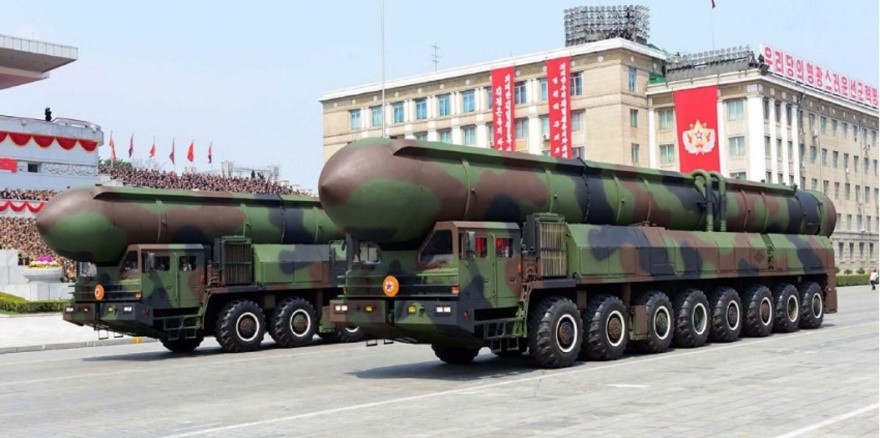
Two Road-mobile ICBMs displayed as part of the April 15th, 2017 parade marking the 105th birthday of the North’s founder Kim Il-sung. It is not known whether these large mobile launchers are mock-ups or house the KN-08 ICBM.
Between December, 2012 and February, 2016, North Korea successfully launched two Unha-3 rockets, which delivered the Kwangmyong-3 and Kwangmyong-4 satellites into orbit. Although the regime stated that these missile launches were a peaceful pursuit of its national space program, it was obvious to most analysts that the program was aimed at further development of ICBM technology of a military nature. Development of a long range ICBM would require the development of a reentry vehicle (RV) that could deliver a nuclear warhead back through earth’s atmosphere without the weapon being destroyed upon reentry. The valuable data gained from the Unha-3 launches will aid North Korea in pursuit of RV development. Although China has developed advanced ICBMs and is engaged in the most ambitious space program in the world at the moment, it has been reluctant to share its knowledge and technology with its northern neighbor. China does not want to be seen as either supporting or condoning such a destabilizing variable in management of the regional conflict.
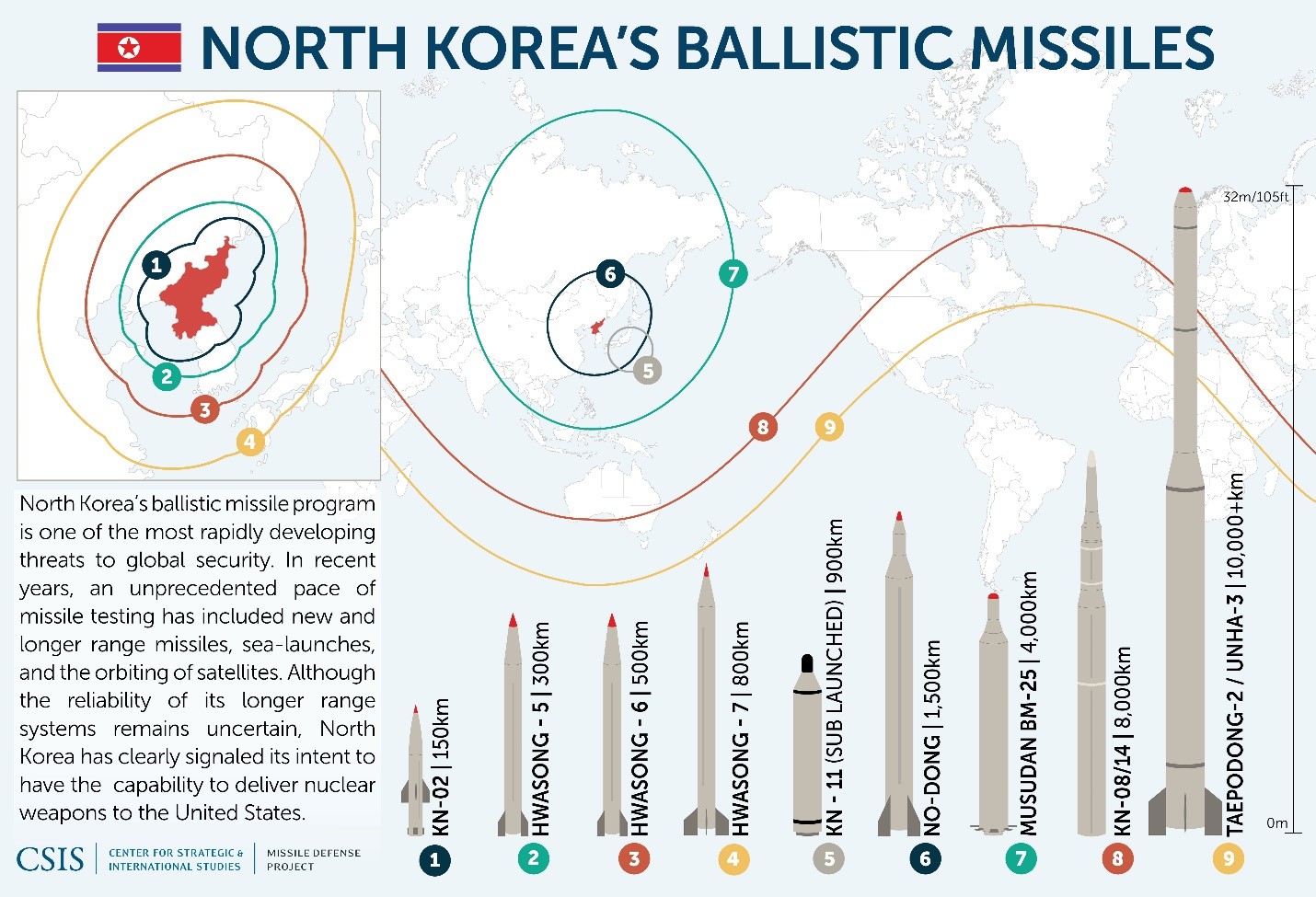
The KN-11, Nogong(C), Musudan, and KN-08 have all been developed, tested and or revealed in the past four years. Their unveiling has coincided with three nuclear weapons tests.
Much has been made of the fledgling North Korean SLBM program; however, very little information is available to develop an educated and informed determination on whether or not North Korea is close to fielding an SLBM. It is not just the matter of developing an SLBM that can be launched while submerged, but in developing a submarine that can house and launch such a weapon. The KN-11 SLBM has been successfully launched while submerged, but it was most likely launched from a test-rig attached to a barge that was ballasted below the surface of the water. Satellite imagery has been captured of such a barge at the Sinpo SLBM test facility.
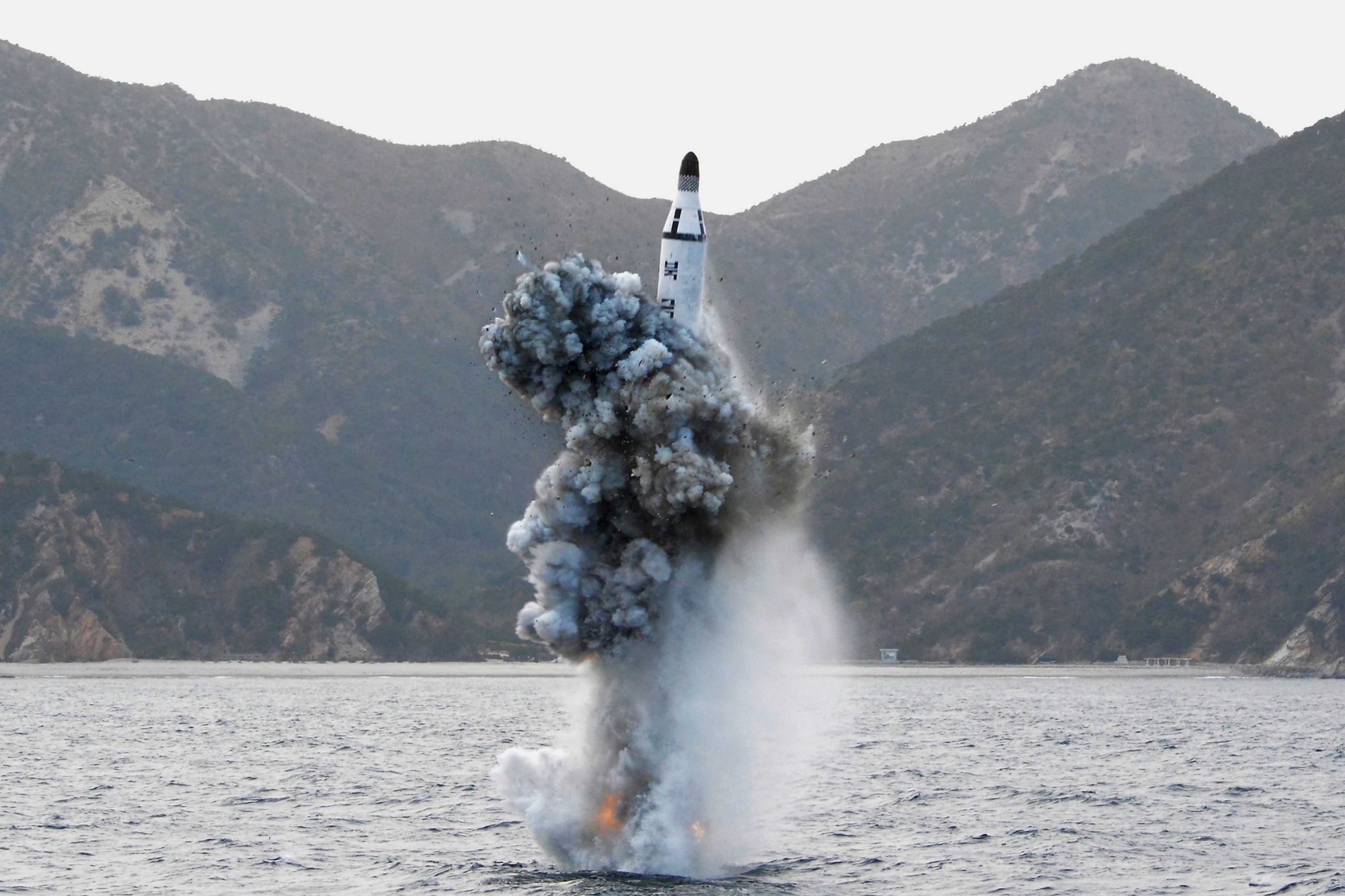
KN-11 missile submerged test launch conducted on August 8th, 2016.
The submarine also observed at the facility, which does not match the dimensions and displacement of all know KPN submarines, dubbed the Sinpo Class, is extremely small, and likely lacks the needed displacement to launch an SLBM at all, let alone while submerged. A number of analysts surmise that the Sinpo was designed to house only one KN-11 SLBM. The Sinpo may be capable of housing one KN-11, but can it actually facilitate the launch of the missile? It is quite doubtful. Even if a Sinpo could launch one KN-11 SLBM equipped with a nuclear warhead, the operational range of such a small diesel electric submarine is probably not greater than 2,500 nautical miles. Assuming that the KN-11 has three times the range as the first successful test launch, which attained a range of 310 miles, the missile would not be capable of striking the continental United States. All U.S. military bases in Japan could be struck, Hawaii and parts of Alaska could possibly be hit, and Guam and Saipan could definitely be targeted. The more important strategic consideration is that a number of Sinpo Class submarines deployed and undetected at sea, could launch a retaliatory strike in response to any preemptive strikes against North Korea carried out by South Korea or the United States. They would represent a primitive, yet effective retaliatory nuclear strike capability.

Sinpo Class submarine. It is hypothesized that one KN-11 SLBM may be housed as to fire vertically up through the rear section of the conning tower.
Who Benefits from North Korean WMD Programs?
North Korea is not the only party that benefits from its study and development of nuclear weapons and ballistic missiles. Although a number of UN resolutions have been adopted to counter the North Korean programs with the aim of limiting the proliferation of such technology and to head-off a conflict on the Korean peninsula, a number of nations have been secretly supporting the efforts of the DPRK and have been benefiting from their nuclear and ballistic missile pursuits. Iran and Pakistan have allegedly been beneficiaries of both North Korean programs, while maintaining a certain level of plausible deniability. There is very little doubt that the Pakistani nuclear weapons program was aided by both North Korea with technical knowledge, and the financial backing of Saudi Arabia.
It is far more convenient and effective for Iran, Pakistan and a number of other nations to use North Korea as an international pariah, to shoulder the majority of research and development, especially the high profile and extremely controversial nuclear detonations and missile launches, than to conduct such activities themselves. This convenient arrangement keeps these partners out of the spotlight and allows them to maintain their international status as law-abiding members of the international community. While China provided a great deal of technical assistance to Pakistan in that nation’s pursuit of a viable nuclear deterrent to a nuclear armed India, it was strong enough in all respects to avoid the political and economic alienation of the world. North Korea cannot dream of enjoying the political and economic influence of China, and must accept its strategic realities.
It is important to keep these inconvenient truths in mind when putting North Korea’s nuclear program in perspective. Where is the international condemnation and resultant ostracizing of Saudi Arabia, Pakistan or China? It is also important to keep the NBC weapons programs of the United States in mind when making moral or ethical evaluation of North Korea. The United States tested the modernized B-61-12, nuclear capable free-fall bomb just this month. The B-61 is a guided bomb, and can deliver a 10kt. to 50kt. (yield is selectable) nuclear payload within a 100ft. radius of accuracy. The U.S. has embarked on a program to acquire 500 of these new bombs, and will be deploying 180 of them to bases in Western Europe and Turkey. Where is the international outrage?
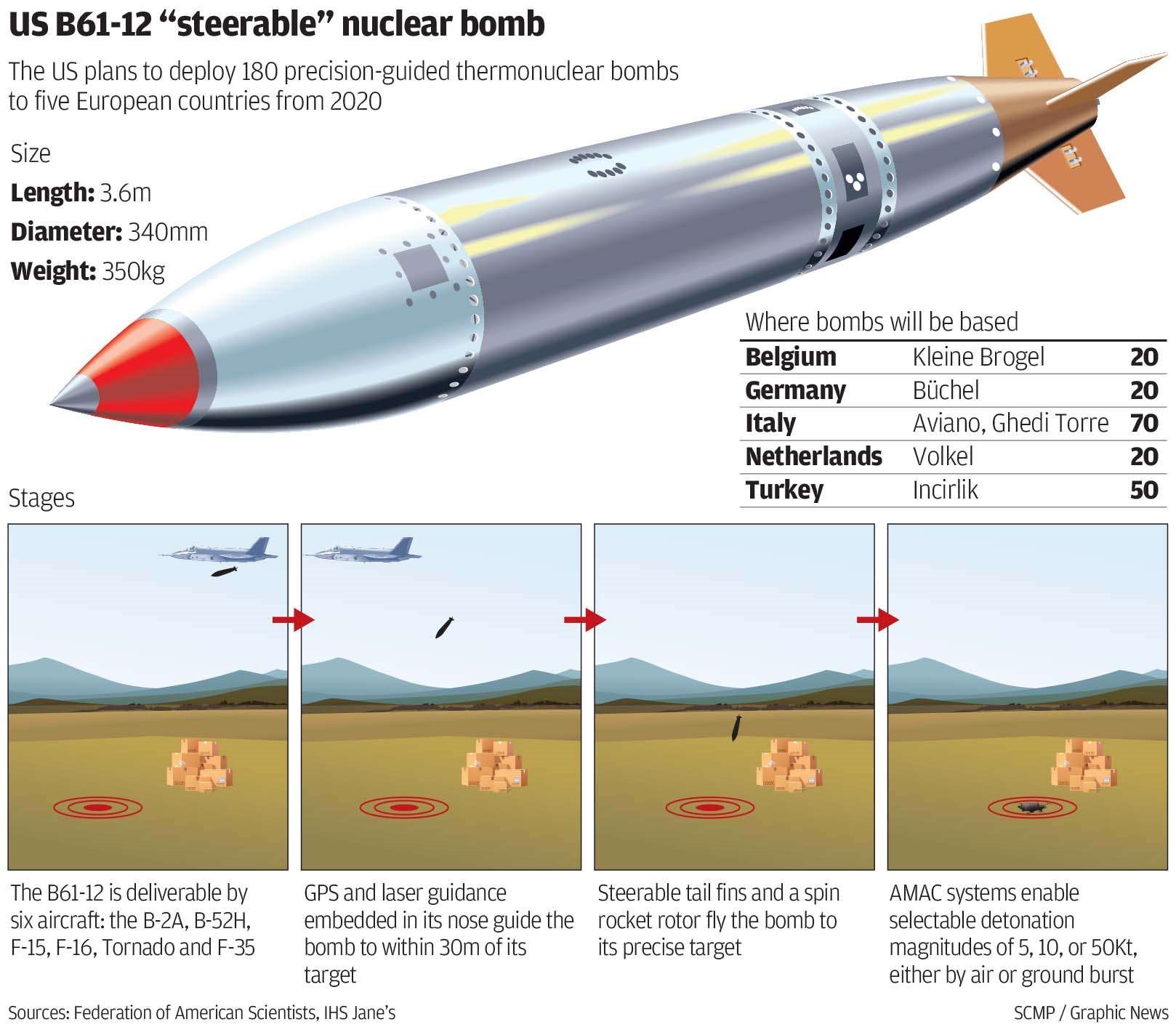
The next generation of aircraft deliverable nuclear bombs in the first leg of the U.S. nuclear triad.
Conclusion
While the world holds its breath in anticipation of a new war on the Korean peninsula, fueled by western mainstream media claims that the Kim Jong-un regime is determined on launching an invasion of South Korea and launching nuclear ICBMs against the continental United States, it is more important than ever to conduct an accurate analysis of the real military capabilities of the DPRK in contrast to its most likely adversaries, notably the Republic of Korea and the United States. This analysis aimed to dispel much of the propaganda of the MSM and to dispel many of the myths associated with the military prowess and threat posed by North Korea. It would be inaccurate and irresponsible to profess that North Korea does not pose a significant military threat to South Korea in the case of a major conflict; however, it would be at a significant disadvantage in all respects. As the United States moves to position BMD capable naval vessels, in conjunction with the ROKN and JMSDF, to the waters around the peninsula and is basing THAAD ABM missiles on South Korean soil, the balance of power is shifting even farther away from North Korea.
The increasingly aggressive moves by the Kim Jong-un regime to acquire a viable nuclear deterrent has fueled increasingly militant moves on the part of the United States to counter such a threat, while increasing the military and political pressure on Pyongyang. These moves have contributed to a spiral of increasingly provocative actions and brinkmanship that threatens to increase the likelihood of a confrontation as opposed to minimizing such an event. China exerts a great deal of political and economic influence over the North Korean leadership, and can most likely defuse the situation if cooler heads prevail within the U.S. administration. As noted earlier, neither China nor the United States desire a solution to the Korean conflict that does not primarily serve their own interests. Any long term peaceful coexistence between North Korea and South Korea likely depends on the determined political will of the leadership of the two Koreas. A workable, negotiated peace treaty and the final, official end to the Korean War between these two parties will only find an origin in the efforts of the Korean people. No outside party has the desire to change the status quo, or to see an end to the loggerhead that has existed for far too long.
A repressive government based on an extreme perversion of socialism, and which utilizes the “cult of personality” to exalt a tiny minority of its population above the majority will ever have any hope of continuing as a viable form of human governance. Any reunification of the two countries will mean the inevitable end of such a system. The Pyongyang regime will resist such an end, just as the United States will continue to fight to ensure its inevitable demise. A number of peace initiates put forward by North Korea in the past must be seen as disingenuous, as they often occurred alongside provocative military developments or controversial nuclear and ballistic missile tests. A number of South Korean peace initiates must also been seen as disingenuous political ploys. While the U.S. strives to see a united, U.S. aligned Korea, China will use all tools at its disposal to prevent such an outcome. In many ways, the fate of the Korean people has been hijacked by global super powers that will do everything to ensure there perpetual separation. Only when this outside influences either agree to step away from the internal matters of the two Koreas, or are somehow removed from the equation, will the two countries on the peninsula be forced to really figure out how to live together as a united people once again.
The coming year may prove to be pivotal in either maintaining or shifting the status quo balance of power in the Asia-Pacific region. As all parties move to both bolster their defense and to exert political and military pressure on their perceived adversaries, increasingly belligerent actions on the part of North Korea and the United States may very well push the region into another horrible conflict. Such a conflict could very likely result in a level of destruction and death not seen since the Second World War, and draw nations from all over the globe into the vacuum of war.






The DPRK has acquired a nuclear deterrent to replace expensive conventional arms.The nuclear program is better than conventional and far cheaper . DPRK success tempts other countries to imitate it. Western oligarchs want to discourage other imitators by inflicting sanctions and other damages. DPRK nuclear stockpile is based on fusion not fissile yield requiring only minimum of scares fissile material as trigger.They have hundreds of nukes. A negotiated display of destruction may be done to discourage imitators. All ground invasion of DPRK would be nuclear annihilated. Three possibilities. Peace.Limited conventional war. Global nuclear war.
First and second options are just as likely, or rather smaller conflicts. Third options is not impossible but most unlikely.
Strange that there is no mention of the russian made MBT and APC that the south korean army uses. they have T80 and BMP 3 also.
I have read No longer in Use, Only training aides now. The BMP 3 were used short term. Along with KA27 helo as SAR helo. All only short term.
So according to this article they are using the m48 while having T80’s sitting idle ? Strange choices , I know the are replacing the m48 , yet it seems odd to prefer it instead of the T80.
Such a good article! Thank you!
Both Koreas need to throw everything they’ve got against ISIS! IMMEDIATELY! BEFORE IT’S TO LATE! NOTHING PREVENTS WAR LIKE A DIFFERENT WAR!
With 30,000 U.S. troops stationed in South Korea and that country standing as a vassal of the US empire, makes no sense this comparison of “north” vs “south”.
Rather would result more useful to get the news about how the North can hit the US, only scaring Trump’s fleet the vassals may surrender.
Well standard of life is way better in south than north korea
Mainly because of the embargo. Under the same economic sanctions South Korea would have turned into an uninhabited country.
Agreed, I am baffled at how long they have hung on in the North? I have also read about the self imposed sanctions in order to be totally self reliant. Very cult like, or maybe something else?
About self imposed sanctions: AFAIK they don’t want to be ruled by Chinese or Russians any more than the Americans. They have physical borders with Russia and China and virtual border with US (and Japan before US). They are “living on the edge”, with very little choices left. By comparation the South Koreans are a bunch of cowards who give in to anyone who asks.
Exactly! If only so much as 100 US soldiers might die from one strike, they will SCRAM it.
Which is why we have only 2 options in this scenario: either there is a conspiracy of DPRK generals, in which case the saber rattling is not just a bluff – or it is just a bluff to demonstrate power when they are slowly losing it. Let’s not be illusional, however, they are working hard and succeeding in weakening Putin’s grip. Although in the end they are just as likely to lose all.
The USSA has already said it would use nuclear weapons in a first strike against Russia, China and whomever they want even when there is no threat of nuclear war and are currently researching how to do it right now and decapitate the leadership of both countries so there is nothing to negotiate. Until the master of the USSA Israel changes its attitude in this regard in
having its vassal USA slave behave in such an aggressive and threatening manner
of invading non-nuclear countries etc. China and Russia must rapidly build up
their own nuclear forces and help countries such as North Korea, Iran Packistan
etc. Belourssia etc. to develop ICBMs and SLBMS; that can strike anywhere in
the world where Zionists are in power.
It is Israeli nut jobs and American Jews who think they can win a nuclear war they say it. I can provide the links if necessary. Therefore until this attitude of world Jewry changes, missile systems are pulled back from Russia and China no more invasions etc Russia and China must help every state not yet conquered by world Jewry to get nuclear weapons that can strike the racist, supremacist, Jewish, empire anywhere on the planet. Nuclear proliferation on a massive scale. If Jewry does not change its quest for world conquest then such proliferation should continue until every single independent state on the planet has ICBMs and SLBMs that can destroy the
world, racist, supremacist, Jewish empire. This is the only way such evil of planning
a nuclear war that Jews think they can win can be deterred.
I suspect once it is clear Russia and China are doing this world Jewry will rapidly change its
war mongering behavior and give up its racist supremacist dreams of global conquest.
If not there will be 50 to 100 or more nuclear powers in 20 years or less and let us see Jewry win a nuclear war with a first strike then.
I concur.
Me Too!
Man, I don’t know about you guys, but I’m exhausted!
great detailed article.
The Peace and reunification candidate Moon is set to win by wide margin May 9th. Once Moon is SK president he will tell US and the billion dollar THAAD to get out. SK could realign with NK . The US Asian empire/alliances could fall apart. So there is pressure for US to attack before May 9th before antiwar candidate wins presidential election. Expect that any US war against DPRK will be called operation “freedom” .But US operation “freedom ” will not survive the “H bomb of Justice”.
You are f……..crazy
Kim is laughing. Park is impeached . Moon will win by huge margin Tuesday. Moon as peace candidate will not keep THAAD which costs a billion and endangers SK. Moon will reopen engagement and economic ties . The DPRK stockpile will continue to expand. When Sixth test occurs it will be 150 to 200 kilotons.Those who thought DPRK would fall crumble or beg …..they were wrong . Reality may seem unbelievable to many. Future shock will affect many.
Developments in ROK show you wrong.
What developments ? Please specify. Look at Jeffrey Lewis tweet. The DPRK mountain can take 350 kt blast . One to two nuclear tests year expected. So a moderate blast is 200 kt. If 200 kt relied on plutonium it would consume entire Pu 239 stockpile. DPRK has energy from light isotope fusion weapons needing only activation energy. Now US is ready for “talks”. DPRK wanted “conservative hardliners “in SK gone. Now that Moon is SK president wait for Sixth test coming soon.
To some degree the DPRK cooperates with US not revealing exact formula or design for light fusion or triggers DPRK use, Other countries can gain knowledge only through experimentation that is banned and punished.
History shows how right you are.
Most elections just seem like they might change something but they never do
A lot of candidates are sincere when they begin. Before its all over many candidates become puppets controlled by those they once despised.
“This operation was pivotal in the North’s complete defeat..”
If they were completely defeated, then why are we having to be subjected to articles like this, and this constant North/South sabre rattling today? ?
Chinas entry saved face for both the us and the dprk
Because the DPRK failed to accomplish any of its goals in the Korean War, and most of the country was burned to the ground by the United states during the war. If China had not intervened, North Korea would no longer exist, as the author points out in the article.
By that token, had it just been between the 2 koreas, the north would’ve swept the south. THE only reason they couldn’t as because of a coalition intervention, which would be thwarted by a Chinese intervention.
Hence, the north was not defeated nor the south, in the end. The war is not over
How come nobody is shooting down NK missiles?
I don’t blame the DPRK for having these WMD’s. It sucks that they do, but the USA has backed them into a corner. Previously I would’ve fallen for the whole he’s a madman hysteria but the Iraq fiasco, the Ghaddafi murder and Yanucovich’s ouster have made me see this in another light. So Kim Jong Un do what ya gotta do buddy. Just don’t start a war man. Great article, gotta read it again.
while this article was quite thorough, its main theme was that america’s superior technology will win the day no matter what. i suggest everyone read this old article on how the opposite is true: rense.com/general37/nkorr.htm
either way, tens of thousands will die if this war breaks out.
The DPRK claims to have mastered ability to demolish Washington . The only way this could be true is if DPRK mastered fusion of light isotopes and yield of fusion to throw weight is higher than published. The US AND USSR have not published the results of 1000 high energy fusion tests. It is not published whether high efficient isotopes with higher yield than lithium deuteride fusion exist. If MT yields exist below 500 kg throw weight, then the US would likely not publish the isotopes and conditions necessary to achieve these results. In 1960s weapons had megaton yields to compensated for low accuracy. Smaller two hundred kiloton weapons were used for US and Russian warheads once accuracy improved. If small high MT warheads were available to DPRK ,in nuclear war DPRK would use the same strategy of MT yield to compensate for low accuracy. DPRK makes clear on KCNA that it is total war ( nuclear war) not limited conventional war if attacked. However , KCNA discussed mostly military targets military bases carriers subs. The only specific civilian city mentioned is Washington not Tokyo . However Pyongyang would not attack city of Washington without expecting a nuclear response to city of Pyongyang and Pyongyang loves its buildings. This leaves that DPRK will not attack unless self defense requires it . If DPRK military is attacked it will initially demonstrate high yield inaccurate MT fusion devices against military targets bases subs and carriers . DPRK hopes that demonstration of multiple MT fusion weapons against multiple military multiple targets would stop military attack and prove it could annihilate civilian centers . If Pyongyang and other civilian cities are attacked it will retaliate against Washington and other large civilian cities . So if Pyongyang is attacked total war on enemy cities will occur. With EMP effects it would be difficult to monitor missile trajectories and type of attack on Pyongyang . A limited nuclear exchange against military targets would be very difficult without total escalation. Expect 200 kiloton yield on DPRK sixth test which is buried deeper to withstand 250 kt. The key is that yield to weight of “sixth test” warhead is still not known . The only way DPRK could fulfill its boast to annihilate Washington is to deliver inaccurate MT yields in 500 kg warheads or less . If DPRK can do that then DPRK must have mastered fusion of something beside lithium deuteride. Yes DPRK was selling lithum deuteride isotopes and may have moved to better isotopes. Yes their will be external warhead reflector of gamma rays to prevent premature detonation by ABM. But this is standard with modern warheads of layer cake design. Of coarse even in nuclear attack against military targets expect EMP devices and detonations immediately as soon as military targets are attacked with nukes. Radar and ABM and most electrical devices will become unreliable instantly. GDP worldwide will plummet just from EMP effect. So achieving limited a limited nuclear war is difficult if EMP escalates and interferes with electrical ABM systems and radar. “Dead hand systems” are effective at dealing with this problem so that entire nuclear arsenal is launched once certain EMP levels are reached. But global nuclear war is not the end of civilization . So support social justice regardless of whether there is a nuclear war. Ironically the yield of the DPRK “H Bomb of Justice” is not known . Is it myth or reality? The sixth test may declare power of justice DPRK which is only nuclear country without common law system or Rothschild bank. The conditions required for MT fusion yields less than 500 kg will not be public .Moon who advocate peace with DPRK is set to win May 9th election. The window for nuclear attack will close once SK openly adopts peace with DPRK. I suspect for political reasons that sixth test will be delayed until after May 9th win Moon .
Nothing on cheap asymmetrical electronic warfare platforms to balance out engagements? GPS jammers….ZM-97 Portable Laster Disturbers….I mean…. most South Korean equipment is Western. We’ve seen successful use of EW efforts by Iran against US equipment. Let us pretend we’re North Korea and we can think rationally of how to engage a superior opponent. How about an analysis that factors that? Because I assure you critical thinking is not monopolized by the West only.
Lucent Technology rents office at 666 Fifth Ave office building owned by Jared Kushner family trust . Lucent makes implantable bio chip markers for the Mark of the Beast. Of coarse if Trump can trigger WWIII by attacking DPRK the global fiat financial system can collapse . Trumps son in law and Lucent Technology and 666 Fifth Ave can replace fiat money with implantable chips. The old problem solution system .
Good discussion.
And I say that grudgingly.
Remember Park wanted to remove Kim of DPRK by any means necessary. Now Park is under arrest. Moon wins election by a landslide. “Moon’s North Korea-related plans revealed so far include reopening and expanding the Kaesong Industrial Complex that was shut down by the Park administration following Pyongyang’s fourth nuclear test in January 2016. Moon has also stated that he will renegotiate issues surrounding the deployment of THAAD missile defense system with the US, and subject the matter to ratification by the National Assembly. “
According to some Russian testimony, the DPRK concentrated on super-EMP type nuclear weapons, with Chinese and Russian help. Gamma ray and microwave output are optimized while blast effects are limited. These are believed to have 40-100 times the EMP output of the much cited Starfish Prime tests. The fact is, those are 40 year old designs maximized for blast effects. The third gen designs that Mk-41 designer Theodore Taylor talked about in 1987 are as different technologically as a rifle is to gunpower. We need to tread carefully here, as a super-EMP weapon could really change the game. Especially since modern electronics are far more sensitive than a string of streetlights (which is what went out from the minimal Starfish EMP).
I doubt it. North Korea even has trouble sticking a nuclear warhead on an ICBM. All this talk about North Korea and an EMP weapon may be used to distract from the US EMP plan for North Korea. It would not be impossible for the US to do a high-atmospheric EMP strike and incapacitate all of North Korea’s electric grid and electronics in one go. The missiles would not work because the electronics that control their launch are fried in this scenario. It would take months to repair everything. The electricity grid would also be damaged. It too would take months to repair everything, if it were possible, in a war scenario.
Computers, electric lights — everything that depends on electricity would be damaged. And the US would aim for the hydroelectric dams. This would wreck North Korea’s electricity supply systems. 70% of North Korea’s electricity comes from hydroelectricity. So many things damaged — North Korea could barely function, let alone fight a war.
ll the missiles and artillery – their electronics damaged – this would be a big blow to the North Koreans. They would find themselves in the Stone Age, and because the detonation of the nuke would be high in the atmosphere, they probably would not know what happened. A sudden blackout with equipment short-circuiting – this would be a disaster.
So I think the USA is thinking of a scenario like that.
If North Korea can create a weapon like this too, it would be a great advantage — it might be more effective than firing nuclear ICBMs at the US mainland. A nuke ICBM could destroy a city, if not intercepted, but the rest of the nation would still go on.
But an EMP strike in the sky would affect the whole nation.
It may become a race to detonate an EMP weapon first against an enemy in the future.
Cyber warfare is also a new frontier in war. Electronic jamming is another.
So EMP/cyber/electronic jamming — all of these will need to be studied and developed (as well as maintaining nuclear deterrents) as the weapons and modes of attack continually evolve.
NK focused on the life insurance: nuclear, chemical and bacteriological weapons.
Yes, conventionally they are not up to date but the others make it . NK got no other choice with the mad agressive western Regimes, who get their script from above. On a long run it seems, that US. is completely doomed. No brain in sight.